谷歌机器学习应用的四十三条经验法则
基于机器学习的无人机航迹规划与集群控制研究

基于机器学习的无人机航迹规划与集群控制研究摘要:无人机技术的发展为航空领域带来了革命性的变化,然而,实现无人机的有效航迹规划和集群控制仍然存在挑战。
本文基于机器学习的方法,探讨了无人机航迹规划和集群控制的研究。
1. 引言随着无人机的广泛应用,如物流、农业监测、环境监测等领域,无人机的航迹规划和集群控制成为关注的热点。
为了提高无人机的飞行效率和安全性,需要采用先进的航迹规划和集群控制算法。
机器学习作为一种强大的工具,可以通过训练数据,使无人机能够自动学习和优化航迹规划和集群控制策略。
2. 无人机航迹规划研究无人机航迹规划的目标是确定最佳的飞行路径,以使无人机能够高效地完成任务,并避免障碍物。
传统的航迹规划方法主要基于经验法则和数学优化模型,但这些方法在复杂环境下表现不佳。
基于机器学习的无人机航迹规划方法能够通过学习大量的飞行数据,自动调整航迹规划策略。
该方法将无人机的历史飞行数据作为输入,训练机器学习模型,以生成最佳航迹规划策略。
3. 无人机集群控制研究无人机集群控制是指多个无人机协同工作完成任务的控制策略。
常见的无人机集群控制方法包括层次控制和分布式控制。
然而,这些方法对集群规模和环境变化较为敏感,缺乏自适应性。
基于机器学习的无人机集群控制方法能够通过学习无人机的运动模式和环境特征,智能地调整控制策略。
这些方法将无人机的传感器数据和飞行状态作为输入,通过训练机器学习模型,实现集群内无人机之间的协同控制。
4. 机器学习算法在无人机航迹规划和集群控制中的应用在无人机航迹规划和集群控制的研究中,机器学习算法被广泛应用。
其中,监督学习算法如神经网络、决策树和支持向量机可以根据无人机的输入特征和输出行为进行训练。
无监督学习算法如聚类分析和自组织映射可以用于无人机集群控制中的任务分配和路径规划。
强化学习算法如Q学习和深度强化学习可以用于无人机集群的智能控制。
5. 挑战和展望尽管基于机器学习的无人机航迹规划和集群控制研究取得了一定的进展,但仍面临一些挑战。
机器学习技术中的农作物产量预测方法解析

机器学习技术中的农作物产量预测方法解析随着农业现代化的推进,农作物产量预测成为农业管理和决策中的重要任务。
传统的农作物产量预测方法往往基于统计分析和经验法则,但这些方法往往需要大量人工参与和繁琐的数据分析,效率低且有时效性差。
而机器学习技术的应用为农作物产量预测带来了巨大的便利性和准确性。
机器学习技术中的农作物产量预测主要依赖于大数据和智能算法。
首先,需要搜集和整理大量的农业数据,包括土壤质量、气候条件、种植历史等。
这些数据将作为模型构建的基础,提供信息来预测农作物产量。
一种常见的机器学习模型是决策树模型。
决策树模型通过对农业数据进行逐步划分,建立一系列规则,从而预测农作物产量。
该模型通常从根节点开始,根据不同的特征属性分裂为多个子节点,直到达到预定的停止条件。
这些子节点表示不同的决策路径,最终形成一个决策树。
决策树模型能够根据数据的特征进行快速的决策,具有可解释性强的特点,适用于农作物产量的预测。
除了决策树,还有随机森林模型在农作物产量预测中广泛应用。
随机森林模型是通过构建多个决策树,并通过综合多个决策树的预测结果来得出最终的预测值。
它能够克服决策树模型中过拟合的问题,提高预测的准确性和稳定性。
随机森林模型还可以用于特征选择,通过评估每个特征的重要性,帮助决策者了解哪些因素对农作物产量具有重要影响。
此外,支持向量机(SVM)也是一种常用的机器学习模型,可应用于农作物产量预测。
支持向量机通过在高维空间中构建一个超平面,将不同类别的数据分开。
在农作物产量预测中,SVM可以根据农业数据的特征属性建立分类边界,从而对农作物产量进行预测。
SVM具有很好的泛化能力和适应性,能够应对较小的数据集和复杂的非线性关系。
除了传统的机器学习方法,神经网络是近年来在农作物产量预测中崭露头角的新兴技术。
神经网络模型模拟了人脑的神经元网络,通过一系列的层次结构来提取和学习数据的特征。
在农作物产量预测中,神经网络可以通过训练大量的数据样本,提取特征并进行预测。
Six sigma basics(6 斯伽马)
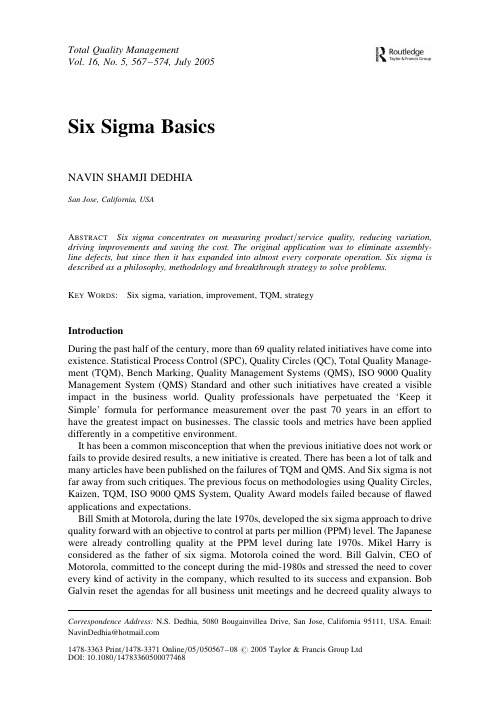
Six Sigma BasicsNAVIN SHAMJI DEDHIASan Jose,California,USAA BSTRACT Six sigma concentrates on measuring product /service quality,reducing variation,driving improvements and saving the cost.The original application was to eliminate assembly-line defects,but since then it has expanded into almost every corporate operation.Six sigma is described as a philosophy,methodology and breakthrough strategy to solve problems.K EY W ORDS :Six sigma,variation,improvement,TQM,strategyIntroductionDuring the past half of the century,more than 69quality related initiatives have come into existence.Statistical Process Control (SPC),Quality Circles (QC),Total Quality Manage-ment (TQM),Bench Marking,Quality Management Systems (QMS),ISO 9000Quality Management System (QMS)Standard and other such initiatives have created a visible impact in the business world.Quality professionals have perpetuated the ‘Keep it Simple’formula for performance measurement over the past 70years in an effort to have the greatest impact on businesses.The classic tools and metrics have been applied differently in a competitive environment.It has been a common misconception that when the previous initiative does not work or fails to provide desired results,a new initiative is created.There has been a lot of talk and many articles have been published on the failures of TQM and QMS.And Six sigma is not far away from such critiques.The previous focus on methodologies using Quality Circles,Kaizen,TQM,ISO 9000QMS System,Quality Award models failed because of flawed applications and expectations.Bill Smith at Motorola,during the late 1970s,developed the six sigma approach to drive quality forward with an objective to control at parts per million (PPM)level.The Japanese were already controlling quality at the PPM level during late 1970s.Mikel Harry is considered as the father of six sigma.Motorola coined the word.Bill Galvin,CEO of Motorola,committed to the concept during the mid-1980s and stressed the need to cover every kind of activity in the company,which resulted to its success and expansion.Bob Galvin reset the agendas for all business unit meetings and he decreed quality always to Total Quality ManagementVol.16,No.5,567–574,July2005Correspondence Address:N.S.Dedhia,5080Bougainvillea Drive,San Jose,California 95111,USA.Email:NavinDedhia@1478-3363Print =1478-3371Online =05=050567–08#2005Taylor &Francis Group Ltd DOI:10.1080=14783360500077468568N.S.Dedhiabefirst.Galvin’s message was,if quality objectives were met,everything else would follow satisfactorily.Galvin would not permit the quality manager to present the quality report. That report had to be provided by the top business unit manager.As a result,the business manager had to understand the qualityfigures to be able to defend the report if it was challenged.Allied Signal was one of thefirst to apply six sigma in its operation.Bob Galvin of Motorola and Jack Welch of General Electric(GE)are good examples of executives,who took a leadership approach in the six sigma methodologies and appli-cations.Six sigma at GE became a company policy in October1995.Six Sigma quality level equates to a3.4Parts Per Million(PPM)defect rate or3.4 defects occurring per million opportunities(DPMO).Six Sigma quality level is like parking a small car in a relatively large space.Quality ToolsDifferent quality tools have a different emphasis.Total Quality Management,Malcolm Baldrige National Quality Award(MBNQA)Criteria for Performance Excellence,ISO 9000Standard and Six Sigma all aim at reducing cost and enhancing customer satisfac-tion.In principle,all these tools can be defined succinctly:Total Quality Management(TQM)The TQM approach creates an awareness in the organization.It is a cost effective system for integrating the continuous improvement efforts of people at all levels in an organi-zation to deliver products,services and solutions,which ensure customer satisfaction. Baldrige Criteria for Performance ExcellenceThe Baldrige Criteria for Performance Excellence focuses on performance excellence for the entire organization in an overall management framework.It identifies and tracks all important organizational results and effectiveness.It helps to determine‘Where the organ-ization is’.Essentially,performance excellence criteria involve the regular and systematic review of an organization’s activities and results.The process allows an organization to clearly discern its strengths and areas for improvement.Baldrige criteria are a holistic integrated set of criteria that addresses best business practices.ISO9000QMS StandardThe ISO9000QMS Standard installs a system in the organization using a process approach.It concentrates onfixing quality system defects and product/service non-conformities.It also helps to document‘What the organization is doing’.It is an organized approach to managing elements of a business in such a way that it fosters continual improvement and customer satisfaction.ISO9000requires fundamental concepts and a framework of process approach to be effective.Six SigmaSix sigma concentrates on measuring product/service quality,reducing variation and driving process improvements and reducing cost.It uses a set of statistical and management tools that can make leaps in improvement.The Six sigma process has a failure rate of3.4Six Sigma Basics569 parts per million(PPM)or99.99966%defect-free product.It uses a complicated approach to problem solving called DMAIC(Define,Measure,Analyse,Improve and Control).Six sigma is the foundation for driving breakthrough improvements.Six Sigma MethodologiesPoor quality costs amount to20to30%of a company’s revenues.Six sigma improvement activities should be carried out in a project form.The prioritization and selection of projects to be worked is vital to the success.A well thought-out introduction plan should be developed.Six sigma should occur in the early life cycle(research and design stage) of a product.Strategic process improvements are needed to compete in the market place. Six sigma in organizations is built around the customer’s needs.A six sigma project recognizes a performance gap,and goes through DMAIC steps before attempting a solution.It is more about reducing variation.Six Sigma is primarily a methodology for improving the capability of business pro-cesses by using statistical methods to identify and decrease or eliminate process variation. Its goal is defect reduction,elimination and improvement.A structured project approach and effective execution of the project are the keys to the success of the Six Sigma process.Characteristics of Six Sigma include:.Expected bottom line results delivered..Senior management leadership..A disciplinedfive step approach using Define,Measure,Analyse,Improve and Control (DMAIC)concept..Rapid project completion..Clearly defined performance measurements..A sound statistical approach to focusing on critical areas of a process for improvement. Six sigma is an evolution of the TQM approach.Six Sigma has integrated other tools and methodologies such as Cause-and-Effect Diagram,Poka-Yoke device(mistake-proof mechanism to prevent obvious errors),Kaizen(continuous improvement),Kanban (pulling of a product instead of pushing through a production process),Lean Manufactur-ing(reducing and preventing wastes),ISO9000(process system approach)and House of Quality(Quality Function Deployment or Voice of the Customer).Fundamentally,.Six Sigma relies on total commitment from leadership team..Projects and initiatives are aligned with strategic objectives of the organizationSix Sigma emphasizes checking,inspection,audit and analysis..Empowered employees tackle issues proactively rather than reactively..Six Sigma is a problem solving methodology using systematic and organized project management tools.Initially,Motorola set a10times improvement during thefirst year,100times improvement during the third year and achieving six sigma during the fourth year.It meant reducing defects by10Âduring thefirst year of launching the program.Then within the next two years reducing defects by100Âto achieve six sigma level during the fourth year.Success requires committing to bold actions,continuous improvement and individual accountability.570N.S.DedhiaDMAIC steps involve:(1)Define:The problem has to be defined clearly and explicitly.It is a major step inselecting and prioritizing a project.A well-defined problem clearly sets ground rules for improvement.(2)Measure:Measurement points,sources,tools and equipment,and precision and accu-racy play a vital role in the project.Without measurement there is no control.Measurements are essential to collect data.(3)Analyse:The right approach in using analytical tools or methods will help tofind aclearly defined solution.Data are analysed into information to create a knowledge base and make decisions for actions.(4)Improve:Selecting the best alternative solution and implementing to remove the causeof a problem will bring the desired result.Improvements can be in the form of efficient equipment,new process,enhanced training to the employees,or new material.Impro-vements are actions,both corrective and preventive.(5)Control:After the implementation of improvement activities,monitoring becomesessential to control the processes.Six Sigma AppreciationCritics have already started labelling six sigma with such phrases as‘sick sigma,program of the month or an old wine in the new bottle’.Allfive senses are required to appreciate the wine.Thesefive senses are see,smell,touch,hear and taste.Six sigma application can only be appreciated when all thefive senses are applied.Thesefive senses play a key vital role in selling the six sigma programme to the management.(1)Seeing or observing with eyesEyes do the function of seeing and observing and thus providing evidence to support the claim.A criminal is innocent until proven guilty with evidence from witnesses.ISO9000standard requires supporting evidence for the observed non-conformity.Six sigma application is appreciated when noticing the benefits received from the six sigma project.These benefits come in the form of a cycle time reduction,cost reduction,savings in resources,yield increase,defect reduction,increase in the profits,space savings,etc.(2)Smelling with the noseA pleasant smell is always enjoyable and creates a thought-provoking environment.An event becomes memorable with a fragrance of a rose or an essence or an aroma of a wine.An organization’s environment remains happy and cheerful from the success of six sigma project and the resulting cost savings.(3)Touching with handsTouching gives a sense about the usefulness of an object and characterizes the surface as rough,smooth,hard or soft.Statistical,analytical and management tools are used to tackle a clearly defined problem.(4)Hearing with earsPeople like to hear sweet words and a sweet voice.Hearing excellent results from the six sigma project is as sweet as a song.Six Sigma Basics571 (5)Tasting with the tongueFood can only be tested when put in the mouth.When an application of six sigma tools and techniques bear the desired results,its value is known.Six Sigma SuccessSix sigma is not like a laser-guided smart bomb,but,rather,a statistically heavy regimen of analysing problems that has saved corporations billions of dollars.Numerous large and well-known corporations such as Motorola,General Electric,American Express,Ford Motor Company,and Allied Signal all have ambitiously applied the six sigma method-ologies in their operations.Impressive results have been obtained by the companies apply-ing a six sigma project in their organizations,as evidenced by:(1)Motorola Legal Department took two years for the patent application.Bob Galvinwanted the patent department tofigure out how to make the application time less ing six sigma tools,the patent department reduced time to somewhat less than that and the shortest time was17days.Motorola generated savings of$1.5 billion in a11year period.(2)A Japanese patent system’s application process cost was reduced from$48,000to$1200for eachfiling.(3)General Electric(GE)increased communication satellites’usage from63%to97%realizing a revenue increase of$1.3million/year.GE changed the original Motorola Six Sigma model to a project based approach that had executive buy-in.GE saved$2 billion during1999.(4)The Ames Rubber Corporation(1993recipient of the Malcolm Baldrige NationalQuality Award in Small Business Category)uses the Baldrige criteria,ISO9000Quality Management System and six sigma tools for continuous improvement activities. (5)The National Science Foundation achieved a reduction of sick people evacuationfrom Antarctica to22%with help from Raytheon Corporation on ways to pre-screening scientists prior to engaging them.(6)A hospital in Milwaukee,Wisconsin,used six sigma process to reduce prescriptionerrors.(7)Samsung Electronics Co.(SEC)of Seoul,Korea,uses six sigma tool for innovation,Efficiency and quality.SEC completed3,290six sigma projects during2000and2001.(8)Using six sigma techniques,American Express improved their plastic issuanceprocesses.(9)DuPont used six sigma methodologies to improve the cycle time to process appli-cations for long-term disability benefits.(10)Fort Wayne,Indiana,local governmentfilled98%of the potholes within24hoursusing six sigma project.(11)Military contractors were early implementers of six sigma(Ex:Northrop Grumman,etc.)(12)US Federal Government authorities are looking into six sigma application tofight the‘war on terrorism’(Homeland Security Project).Companies save an average of$100,000to$200,000per implemented improvement panies that have produced good results,have invested adequate resources, provided extensive training and involved many individuals.572N.S.DedhiaSix sigma success requires:.Strong proactive support with required resources provided by the top management. .Acceptance and implementation of six sigma’s basic disciplines by employees.The role of middle management has to be active and supportive for the success of a six sigma. Managers at all levels are required to be active..Linkage with all innovative and infrastructure activities..Accurate and fair evaluation of all successful six sigma projects with meaningful recognition and rewards for employees.General Electric made it clear that there will be no promotions without active participation in six sigma activities.Volvo refers to its Black Belts at future leaders.Lean Six SigmaThe lean manufacturing technique was developed by Toyota Motor Corporation in Japan. Lean tools are used to reduce waste and improve the efficiency of a process.Six sigma tools are used when the goal is to reduce variance and improve the performance. Keeping in mind the constraints,the lean manufacturing technique focuses on eliminating barriers to achieve a smooth continuous processflow.In six sigma,the focus is on elim-inating variation to reduce cost and cycle time and improve quality.Subject experts are trained differently and subjects are deployed differently in lean manufacturing and six sigma.Their approachesfit different types of problems.Lean and six sigma have a positivefinancial impact.Both need management’s active support and both can also be used in the non-manufacturing environment.Savings can be doubled,when lean and six sigma are used in a coordinated manner.Total Productive Maintenance(TPM)is used in the lean manufacturing technique to ensure equipment is operational and available when required.Single Minute Exchange of Dies(SMED)from the lean technique and Design of Experiment(DOE)from six sigma are used to achieve optimal results.The lean technique is aimed at creatingflow through the entire value stream.Six sigma works on reducing variation among the processes that operate on a product.Lean helps uncover the rocks in the value stream that can cause blockages or unnecessary variation in theflow.Six sigma helps tofind the rocks in the value stream.Lean goes beyond Just-In-Time(JIT)and TQM.Six sigma goes beyond TQM.Lean and six sigma both focus on increasing productivity,asset utilization and quality.Six Sigma BenefitsA number of benefits are realized when the six sigma process is applied in a systematic way.A hugefinancial payoff is realized within a short period of time.Some of these benefits are:.Decreased work-in-progressBottlenecks are removed and workflows smoothly in the line,thereby reducing in process inventory.Equipment and tools are utilized efficiently with decreased work-in-progress.There is no wait in line.Six Sigma Basics573 .Improved capacity and outputDue to decreased work-in-process,more can be produced and shipped..Improved customer satisfaction and processflowOn-time shipping and on-time delivery of goods will make customers happy..Improved inventory turnsWith decreased work-in-progress and improved output,product will move faster out the door.There will be less inventory of raw material andfinished product..Increased productivityProductivity increase is realized when equipment and tools are running at capacity and wastage is reduced..Reduced cycle timeFrom start tofinish,the job can be done within the prescribed time.Waiting is removed from the operation.Six Sigma EnvironmentThe success of a Six Sigma project depends on the role played by the team members,who are:(a)Executive(Involve in committing resources and sponsoring the project)(b)Master Black Belt(Training and coaching)(c)Black Belt(Lead improvement projects)(d)Green Belt(Support and run projects)(e)Champion(Involve in supporting the project)Master Black Belts(MBBs)provide training and support for both Black and Green Belts. Black Belts(BB)and Green Belt(GB)holders conduct the improvement projects.Master Black Belt and Black Belt holders are full-time improvement specialists having obtained four weeks’training over a four-month period.Green Belt holders are part-time improve-ment specialist and retain their previous job duties.They receive two weeks’training over a two-month period.Executive leaders establish the strategic focus of a Six Sigma programme.Champions take their company’s vision,missions,goals,and metrics and translate them for individual projects.The Executives and champions keep the programme moving in a planned direction.Executives attend a one-day Executive training session. Champions receive one week of training.Mikel Harry,one of Six Sigma’s creators and chief promoters,introduced the belt system for designating experience levels.Master Black Belts and Black Belts form the backbone of the Six Sigma program.Questions still arise at the validity of six sigma application infixing rare and random problems.Fewer than15%of the Fortune1000companies have embraced it in a significant way.Michael Dell,CEO of Dell Computers,says it is powerful stuff.Jack Welch,CEO of GE,says it requires obsessive and compulsive commitment to drive six sigma deep into a company’s culture.Success of six sigma demands on management com-mitment,full support,a trained workforce and cross-functional teams.The American Society for Quality(ASQ)offers the Six Sigma Black Belt(SSBB) Certification Examination twice a year.It is a150multiple-choice-question four-hour574N.S.Dedhiaexamination.The ASQ certification examination application requires two completed six sigma projects documented by signed affidavits or one project with a signed affidavit and three years of work experience related to six sigma activities.ASQ certification is not a licence or registration.It is peer recognition.ASQ launched a quarterly Six Sigma Forum Magazine in June2002.An annual six sigma conference is held by ASQ.ASQ started the Six Sigma Forum in May2001with an aim of connecting six sigma knowledge with experience for quality professionals.The ASQ Six Sigma Black Belt examination requires knowledge and understanding of:(1)Enterprise wide deployment(2)Business process management(3)Project management(4)Defining,measuring,analysing,improving and controlling six sigma improvementmethodology and tools(5)Lean enterprise(6)Design for six sigmaConclusionSix sigma,as developed by Motorola,was an extension of many existing quality tools and techniques,but with the addition of business accountability.This resulted in process improvement gains that increased productivity and profitability.Six sigma and Lean enter-prise methodologies are both systematic and both have evolved from separate paths.Lean was developed by Toyota.Lean is mainly focused on eliminating waste.In manufacturing, the lean principle includes zero waiting time,pull instead of push scheduling,smaller batch sizes,line balancing and shorter process times.Six Sigma organizations become forward moving organizations by adapting new tools and techniques and overcoming learning disabilities.Much can be achieved from programmes like six sigma with the active,consistent, innovative,continuous and widely apparent participation by top management.When implemented strategically,six sigma can help companies turn over working capital faster,reduce capital spending,make existing capacity available,produce better results from the design and R&D functions.Such outcomes also foster a working environ-ment that stimulates employee development,motivation,morale empowerment and commitment.The primary factor in the successful implementation of a six sigma project is to have the necessary resources,the support and leadership of top management,customer require-ments identified explicitly,and a comprehensive training programme.Six sigma’s DMAIC structure of problem solving is its ability to analyse,improve and control processes with an emphasis on the ability to measure the performance.Deploy-ment of six sigma is best achieved through the defined projects.Success of a six sigma project depends on buy-in by the entire organization,deployment of the process,effective training and key measurements.。
SIMATIC Visualization Architect系统手册
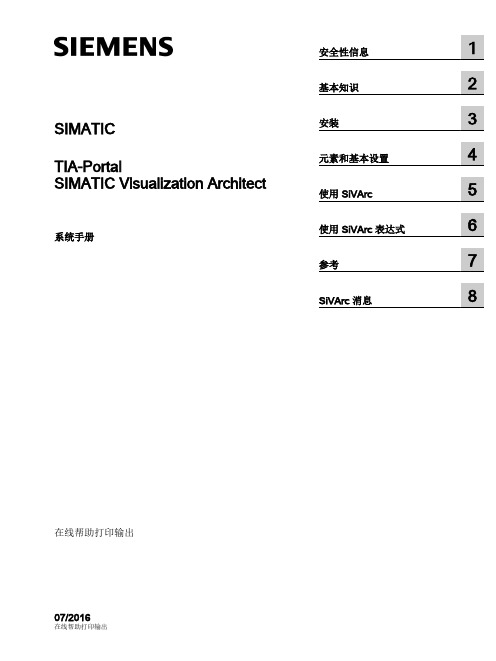
危险 表示如果不采取相应的小心措施,将会导致死亡或者严重的人身伤害。
警告 表示如果不采取相应的小心措施,可能导致死亡或者严重的人身伤害。
小心 表示如果不采取相应的小心措施,可能导致轻微的人身伤害。
注意 表示如果不采取相应的小心措施,可能导致财产损失。
当出现多个危险等级的情况下,每次总是使用最高等级的警告提示。如果在某个警告提示中带有警告可能导致人身 伤害的警告三角,则可能在该警告提示中另外还附带有可能导致财产损失的警告。
安全性信息
1
基本知识
2
SIMATIC
安装
3
TIA-Portal
元素和基本设置
4
SIMATIC Visualization Architect
使用 SiVArc
5
系统手册
使用 SiVArc 表达式
6
参考
7
SiVArc 消息
8
在线帮助打印输出 07/2016
在线帮助打印输出
法律资讯 警告提示系统ቤተ መጻሕፍቲ ባይዱ
为了您的人身安全以及避免财产损失,必须注意本手册中的提示。人身安全的提示用一个警告三角表示,仅与财产 损失有关的提示不带警告三角。警告提示根据危险等级由高到低如下表示。
2.3
关于使用 SiVArc 的基础知识..........................................................................................17
2.4
支持的设备......................................................................................................................21
参数设置的名词解释
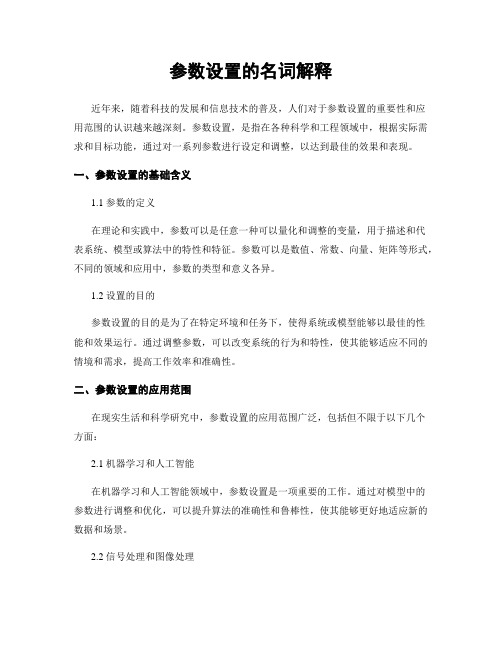
参数设置的名词解释近年来,随着科技的发展和信息技术的普及,人们对于参数设置的重要性和应用范围的认识越来越深刻。
参数设置,是指在各种科学和工程领域中,根据实际需求和目标功能,通过对一系列参数进行设定和调整,以达到最佳的效果和表现。
一、参数设置的基础含义1.1 参数的定义在理论和实践中,参数可以是任意一种可以量化和调整的变量,用于描述和代表系统、模型或算法中的特性和特征。
参数可以是数值、常数、向量、矩阵等形式,不同的领域和应用中,参数的类型和意义各异。
1.2 设置的目的参数设置的目的是为了在特定环境和任务下,使得系统或模型能够以最佳的性能和效果运行。
通过调整参数,可以改变系统的行为和特性,使其能够适应不同的情境和需求,提高工作效率和准确性。
二、参数设置的应用范围在现实生活和科学研究中,参数设置的应用范围广泛,包括但不限于以下几个方面:2.1 机器学习和人工智能在机器学习和人工智能领域中,参数设置是一项重要的工作。
通过对模型中的参数进行调整和优化,可以提升算法的准确性和鲁棒性,使其能够更好地适应新的数据和场景。
2.2 信号处理和图像处理在信号处理和图像处理中,参数设置常常用于调整算法的敏感度和响应速度。
通过设定合适的参数,可以提高信号和图像的质量和清晰度,减少噪声和失真的影响。
2.3 优化问题和数值计算在优化问题和数值计算中,参数设置对于算法的收敛速度和解的准确性至关重要。
通过调整参数,可以找到最优的解或近似最优解,同时提高算法的计算效率和鲁棒性。
2.4 控制系统和自动化领域在控制系统和自动化领域中,参数设置用于调整系统的响应速度、稳定性和控制精度。
通过合理设置参数,可以实现对系统状态的精确控制,提高生产和操作效率。
三、参数设置的方法和技巧3.1 经验法则在实践中,人们根据经验和观察总结出一系列参数设置的规律和法则。
例如,在机器学习领域,学者们提出了许多经验法则,如网格搜索、随机搜索等,用于确定最优的参数组合。
SPC手册中文版

质量管理/技术统计9.设备和过程能力科技成就生活之美第3版 20##07月01日第2版 1991年07月29日第1版 1990年04月11日本手册给出能力和性能指标的最低要求,版本日期出版时有效。
如有冲突,QSP0402的要求具有约束力和优先于本手册。
设备和过程能力目录页码1. 介绍 ........................................................................................ (4)2. 术语......................................................................................... (4)3. 设备和过程能力研究流程图 (6)4. 设备能力研究......................................................................................... . (7)4.1 一台设备详细能力研究 (8)4.2 数据评估 ........................................................................................ .. (9)短期稳定性研究 (9)标准方法......................................................................................... . (9)计算程序手册 (11)4.3对设备能力不足采取的措施 (12)5. 过程能力研究......................................................................................... . (14)5.1 程序......................................................................................... .. (14)5.2 数据评估〔标准方法〕 (14)过程稳定性研究〔变异分析和F测试〕 (14)统计分布研究 (15)过程能力统计指数 (15)5.3 数据评估评估〔计算程序手册〕 (16)过程稳定性研究 ............................................................................16统计分布研究 (16)过程能力统计指数 (16)6. 统计指数解释 (18)6.1 统计指数和部分不符合的联系 (18)6.2 样本大小的作用 ........................................................................................ (19)6.3 测量系统的作用 (19)7. 质量特性统计指数 (20)8. 性能指数统计报告 (20)9. 统计指数计算方法 (21)9.1 方法M1 ........................................................................................ . (21)9.2 方法M2 ........................................................................................ . (22)9.3 方法 M3 <围方法>.........................................................................................229.4 方法 M4 <分位数方法> (23)10. 模型分布 ........................................................................................ . (24)10.1 约翰逊族分布 (24)10.2 正态分布 (25)11. 例子 ........................................................................................ (26)12. 两个空间指数统计指数 (30)13. 表格......................................................................................... (31)14. 缩写词......................................................................................... (37)15. 参考文献......................................................................................... (39)索引......................................................................................... . (40)1. 介绍必须申请适当的方法检测,如果适用的话,进行过程测量,这些方法应证实有能力的过程实现所策划的结果。
10种常用机器学习算法简介

10种常用机器学习算法简介在机器学习领域,有种说法叫做“世上没有免费的午餐”,简而言之,它是指没有任何一种算法能在每个问题上都能有最好的效果,这个理论在监督学习方面体现得尤为重要。
举个例子来说,你不能说神经网络永远比决策树好,反之亦然。
模型运行被许多因素左右,例如数据集的大小和结构。
因此,你应该根据你的问题尝试许多不同的算法,同时使用数据测试集来评估性能并选出最优项。
当然,你尝试的算法必须和你的问题相切合,其中的门道便是机器学习的主要任务。
打个比方,如果你想打扫房子,你可能会用到吸尘器、扫帚或者拖把,但你肯定不会拿把铲子开始挖坑吧。
对于渴望了解机器学习基础知识的机器学习新人来说,这儿有份数据科学家使用的十大机器学习算法,为你介绍这十大算法的特性,便于大家更好地理解和应用,快来看看吧。
一、线性回归线性回归可能是统计学和机器学习中最知名和最易理解的算法之一。
由于预测建模主要关注最小化模型的误差,或者以可解释性为代价来做出最准确的预测。
我们会从许多不同领域借用、重用和盗用算法,其中涉及一些统计学知识。
线性回归用一个等式表示,通过找到输入变量的特定权重(B),来描述输入变量(x)与输出变量(y)之间的线性关系。
举例:y = B0 + B1 * x给定输入x,我们将预测y,线性回归学习算法的目标是找到系数B0和B1的值。
可以使用不同的技术从数据中学习线性回归模型,例如用于普通最小二乘和梯度下降优化的线性代数解。
线性回归已经存在了200多年,并且已经进行了广泛的研究。
如果可能的话,使用这种技术时的一些经验法则是去除非常相似(相关)的变量并从数据中移除噪声。
这是一种快速简单的技术和良好的第一种算法。
二、逻辑回归逻辑回归是机器学习从统计领域借鉴的另一种技术。
这是二分类问题的专用方法(两个类值的问题)。
逻辑回归与线性回归类似,这是因为两者的目标都是找出每个输入变量的权重值。
与线性回归不同的是,输出的预测值得使用称为逻辑函数的非线性函数进行变换。
不可不知的11个重要机器学习模型评估指标

作者 | Arno来源 | 磐创AI【磐创AI导读】:评估一个模型是建立一个有效的机器学习模型的核心部分,本文为大家介绍了一些机器学习模型评估指标,希望对大家有所帮助。
概览∙评估一个模型是建立一个有效的机器学习模型的核心部分∙评价指标有混淆矩阵、交叉验证、AUC-ROC曲线等。
∙不同的评估指标用于不同类型的问题介绍建立机器学习模型的想法是基于一个建设性的反馈原则。
你构建一个模型,从指标中获得反馈,进行改进,直到达到理想的精度为止。
评估指标解释了模型的性能。
评估指标的一个重要方面是它们区分模型结果的能力。
我见过很多分析师和数据科学家不费心检查他们的模型的鲁棒性。
一旦他们完成了模型的构建,他们就会匆忙地将其应用到不可见的数据上。
这是一种错误的方法。
你的动机不是简单地建立一个预测模型。
它是关于创建和选择一个模型,使其对样本外的数据具有高精度。
因此,在计算预测值之前,检查模型的准确性是至关重要的。
在我们的行业中,我们考虑不同种类的指标来评估我们的模型。
指标的选择完全取决于模型的类型和模型的实现计划。
在你构建完模型之后,这11个指标将帮助你评估模型的准确性。
考虑到交叉验证的日益流行和重要性,我还将在本文中讨论它。
热身:预测模型的类型当我们谈论预测模型时,我们谈论的要么是回归模型(连续输出),要么是分类模型(离散输出)。
这些模型中使用的评估指标是不同的。
在分类问题中,我们使用两种类型的算法(取决于它创建的输出类型):1.类输出: 像SVM和KNN这样的算法创建一个类输出。
例如,在一个二分类问题中,输出将是0或1。
然而,今天我们有算法可以将这些类输出转换为概率。
但是这些算法并没有被统计学界很好地接受。
2.概率输出: 逻辑回归、随机森林、梯度增强、Adaboost等算法给出概率输出。
将概率输出转换为类输出只需要创建一个阈值。
在回归问题中,我们的输出没有这样的不一致性。
输出在本质上总是连续的,不需要进一步处理。
例证分类模型评估指标的讨论中,我使用了我在Kaggle上的BCI挑战的预测。
互联网名词大全
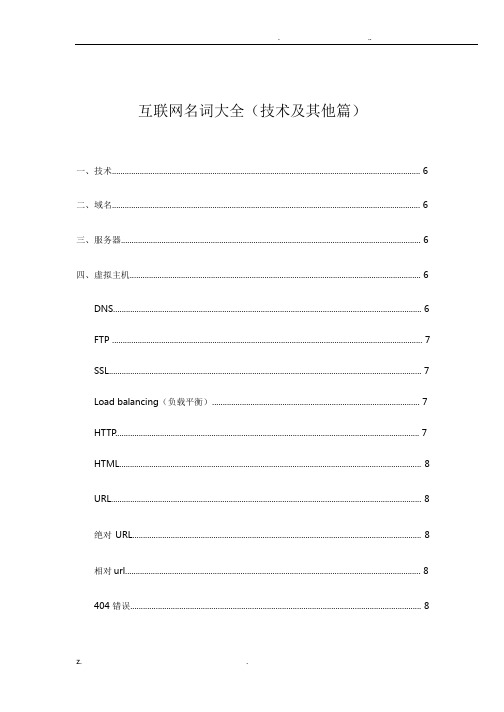
互联网名词大全(技术及其他篇)一、技术 (6)二、域名 (6)三、服务器 (6)四、虚拟主机 (6)DNS (6)FTP (7)SSL (7)Load balancing(负载平衡) (7)HTTP (7)HTML (8)URL (8)绝对URL (8)相对url (8)404 错误 (8)Session (9)CMS (9)开放平台 (9)API (10)SDK (10)Native app (10)Web app (10)Html5 (11)大数据 (11)数据挖掘 (11)机器学习 (11)云存储 (12)NFC (12)RFID (12)VR (12)二、其他 (13)SWOT 分析 (13)Prototype、产品原型 (13)Flow Chart 流程图 (13)MRD 市场需求文档 (13)BRD 商业需求文档 (14)PRD 产品需求文档 (14)AB 测试 (14)灰度发布 (14)快速检查清单(Check list) (14)FAQ (15)MVP(Minimum Viable Product –最简化可实行产品) (15)#职位、职业或部门相关# (15)CEO 首席执行官 (15)COO 首席运营官 (15)CMO 首席市场官 (15)CFO 首席财务官 (15)VP 副总裁 (15)PM 产品经理、项目经理 (15)OP 运营 (15)UI 设计 (15)UED 用户体验 (15)BD 商务拓展 (16)AE 客户执行 (16)PR 公关 (16)HR 人力资源 (16)HRD 人力资源总监 (16)KA 大客户部门 (16)Soho (16)Geek (16)淘宝客 (16)淘拍档 (16)#其他# (17)Aidma 模型 (17)长尾理论 (17)七次印象理论 (18)八秒法则 (18)避风港原则 (18). ..一、技术域名由一串用点分隔的名字组成的Internet 上某一台计算机或计算机组的名称,用于在数据传输时标识计算机的电子方位。
如何调整机器学习中的正则化参数选择

如何调整机器学习中的正则化参数选择机器学习中的正则化参数选择是一个关键的问题,它决定了模型的复杂度和泛化能力。
合适的正则化参数可以避免过拟合和欠拟合问题,提高模型的性能和泛化能力。
本文将介绍如何调整机器学习中的正则化参数选择。
在机器学习中,正则化是一种常见的技术,通过添加一个正则化项来约束模型的复杂度。
正则化项在损失函数中引入了一个惩罚项,惩罚模型的复杂度,从而避免模型过度拟合训练数据。
正则化参数控制着惩罚项的强度,因此其选择非常重要。
要调整机器学习中的正则化参数选择,可以采用以下几种方法:1. 经验法则:根据经验法则调整正则化参数是一种常见的方法。
经验法则指出,当训练样本较少时,应该选择较小的正则化参数;当训练样本较多时,可以选择较大的正则化参数。
这是因为较小的正则化参数可以减小过拟合的风险,而较大的正则化参数可以限制模型的复杂度。
但是,经验法则只是一种启发性的指导,并不能保证最佳性能。
2. 网格搜索:网格搜索是一种较为常用的调参方法。
它通过将不同取值的正则化参数组合成一个网格,然后遍历网格中的所有组合,根据某种评价指标(如交叉验证误差)来选择最佳的正则化参数。
网格搜索需要预先定义候选的正则化参数的范围和步长,需要在给定的搜索空间中进行穷举搜索,因此耗时较长。
然而,网格搜索能够保证找到参数空间中的最优解。
3. 随机搜索:随机搜索是一种相对快速的调参方法。
与网格搜索不同,随机搜索不需要遍历整个参数空间,而是在给定的范围内随机选择参数值进行评估。
通过随机搜索,可以在相对较少的计算量下找到较好的参数组合。
然而,由于随机性的存在,随机搜索不能保证找到全局最优解。
4. 贝叶斯优化:贝叶斯优化是一种高效的参数调整方法。
它通过构建参数空间的概率模型,利用回归模型进行优化。
贝叶斯优化可以根据模型的评估结果,自适应地调整参数空间的搜索策略,从而快速找到最佳参数。
贝叶斯优化适用于参数空间连续且维度较高的情况。
5. 使用验证集:将数据集划分为训练集、验证集和测试集是一种常见的方法。
机器学习技术使用中的训练样本数量实用经验

机器学习技术使用中的训练样本数量实用经验机器学习是一种广泛应用于各个领域的技术,它通过对大量数据的学习和分析,从中发现规律和模式,并且能够用于预测和决策。
在机器学习的过程中,训练样本的数量是非常关键的因素,它直接决定了模型的泛化能力和准确度。
本文将介绍在使用机器学习技术时,训练样本数量的一些实用经验。
1. 数据量与模型复杂度的关系在机器学习中,通常情况下,数据量越大,模型的结果越好。
这是因为较大的数据集可以更好地代表真实世界,并且能够提供更多的信息用于训练。
当我们需要构建一个复杂的模型时,需要更多的数据来满足其学习需求。
然而,数据量并不是越大越好,当数据量超过一定的阈值时,模型的改进效果会逐渐减弱。
2. 样本数量与模型的稳定性样本数量越多,模型的稳定性越高。
通过增加训练样本的数量,可以减小模型对于个别样本的过拟合风险。
当训练样本数量较少时,模型可能会过度关注于少数样本的特殊特征,导致模型无法很好地泛化到未见过的数据。
因此,为了保证模型的稳定性和准确度,我们需要尽可能地收集更多的样本数据。
3. 样本数量与数据的质量在机器学习中,数据的质量同样重要于数量。
即使拥有大量的训练样本,如果数据质量很差,那么训练出的模型也无法达到预期的效果。
因此,在选择训练样本数量时,我们需要确保数据的完整性、准确性和代表性。
高质量的数据可以提供更有力的支持,使得模型的结果更加可靠可信。
4. 样本数量与时间成本获取大量的训练样本需要耗费大量的时间和资源。
这包括数据采集、清洗、标注等过程。
在实际应用中,我们必须在时间和成本之间寻找平衡。
根据具体应用场景和任务的需求,可以选择合适的样本数量。
如果有时间和资源限制,可以使用一些数据增强技术来扩充训练样本的数量,如数据集扩增、数据生成等方法,以达到提高模型泛化能力的目的。
5. 选择样本数量的经验法则在机器学习领域,有一些经验法则可以帮助我们选择合适的训练样本数量。
其中一种常用的经验法则是“大约足够的数据量”法则,即使用足够多的数据来确保模型有较好的性能表现。
ISO 9000-2015基础与术语(E,20150915)
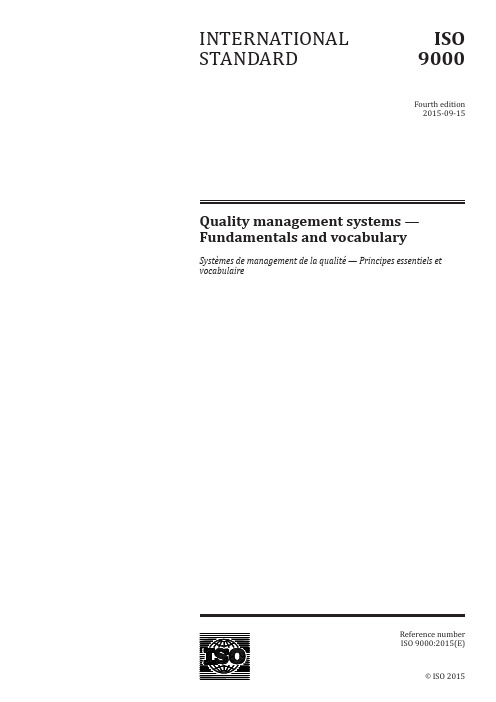
© ISO 2015Quality management systems — Fundamentals and vocabularySystèmes de management de la qualité — Principes essentiels et vocabulaireINTERNATIONAL STANDARDISO 9000Fourth edition 2015-09-15Reference number ISO 9000:2015(E)ISO 9000:2015(E)ii© ISO 2015 – All rights reservedCOPYRIGHT PROTECTED DOCUMENT© ISO 2015, Published in SwitzerlandAll rights reserved. Unless otherwise specified, no part of this publication may be reproduced or utilized otherwise in any form or by any means, electronic or mechanical, including photocopying, or posting on the internet or an intranet, without prior written permission. Permission can be requested from either ISO at the address below or ISO’s member body in the country of the requester.ISO copyright officeCh. de Blandonnet 8 • CP 401CH-1214 Vernier, Geneva, Switzerland Tel. +41 22 749 01 11Fax +41 22 749 09 47copyright@ --`,,,``,`````,,``,,,``,`,,,-`-`,,`,,`,`,,`---ISO 9000:2015(E)Contents Page Foreword (iv)Introduction (v)1 Scope (1)2 Fundamental concepts and quality management principles (1)2.1 General (1)2.2 Fundamental concepts (2)2.2.1 Quality (2)2.2.2 Quality management system (2)2.2.3 Context of an organization (2)2.2.4 Interested parties (2)2.2.5 Support (2)2.3 Quality management principles (3)2.3.1 Customer focus (3)2.3.2 Leadership (4)2.3.3 Engagement of people (5)2.3.4 Process approach (6)2.3.5 Improvement (6)2.3.6 Evidence-based decision making (7)2.3.7 Relationship management (8)2.4 Developing the QMS using fundamental concepts and principles (9)2.4.1 QMS model (9)2.4.2 Development of a QMS (9)2.4.3 QMS standards, other management systems and excellence models (10)3 Terms and definitions (10)3.1 Terms related to person or people (10)3.2 Terms related to organization (11)3.3 Terms related to activity (13)3.4 Terms related to process (15)3.5 Terms related to system (16)3.6 Terms related to requirement (18)3.7 Terms related to result (20)3.8 Terms related to data, information and document (23)3.9 Terms related to customer (25)3.10 Terms related to characteristic (26)3.11 Terms related to determination (27)3.12 Terms related to action (29)3.13 Terms related to audit (30)Annex A (informative) Concept relationships and their graphical representation (33)Bibliography (47)Alphabetical index of terms (49)© ISO 2015 – All rights reserved iiiISO 9000:2015(E)ForewordISO (the International Organization for Standardization) is a worldwide federation of national standards bodies (ISO member bodies). The work of preparing International Standards is normally carried out through ISO technical committees. Each member body interested in a subject for which a technical committee has been established has the right to be represented on that committee. International organizations, governmental and non-governmental, in liaison with ISO, also take part in the work. ISO collaborates closely with the International Electrotechnical Commission (IEC) on all matters of electrotechnical standardization.The procedures used to develop this document and those intended for its further maintenance are described in the ISO/IEC Directives, Part 1. In particular the different approval criteria needed for the different types of ISO documents should be noted. This document was drafted in accordance with the editorial rules of the ISO/IEC Directives, Part 2 (see /directives). Attention is drawn to the possibility that some of the elements of this document may be the subject of patent rights. ISO shall not be held responsible for identifying any or all such patent rights. Details of any patent rights identified during the development of the document will be in the Introduction and/or on the ISO list of patent declarations received (see /patents).Any trade name used in this document is information given for the convenience of users and does not constitute an endorsement.For an explanation on the meaning of ISO specific terms and expressions related to conformity assessment, as well as information about ISO’s adherence to World Trade Organization (WTO) principles in the Technical Barriers to Trade (TBT) see the following URL: /iso/foreword.html. The committee responsible for this document is Technical Committee ISO/TC 176, Quality management and quality assurance, Subcommittee SC 1, Concepts and terminology.This fourth edition cancels and replaces the third edition (ISO 9000:2005), which has been technically revised.iv© ISO 2015 – All rights reservedISO 9000:2015(E)IntroductionThis International Standard provides the fundamental concepts, principles and vocabulary for quality management systems (QMS) and provides the foundation for other QMS standards. This International Standard is intended to help the user to understand the fundamental concepts, principles and vocabulary of quality management, in order to be able to effectively and efficiently implement a QMS and realize value from other QMS standards.This International Standard proposes a well-defined QMS, based on a framework that integrates established fundamental concepts, principles, processes and resources related to quality, in order to help organizations realize their objectives. It is applicable to all organizations, regardless of size, complexity or business model. Its aim is to increase an organization’s awareness of its duties and commitment in fulfilling the needs and expectations of its customers and interested parties, and in achieving satisfaction with its products and services.This International Standard contains seven quality management principles supporting the fundamental concepts described in 2.2. In 2.3, for each quality management principle, there is a “statement” describing each principle, a “rationale” explaining why the organization would address the principle, “key benefits” that are attributed to the principles, and “possible actions” that an organization can take in applying the principle.This International Standard contains the terms and definitions that apply to all quality management and QMS standards developed by ISO/TC 176, and other sector-specific QMS standards based on those standards, at the time of publication. The terms and definitions are arranged in conceptual order, with an alphabetical index provided at the end of the document. Annex A includes a set of diagrams of the concept systems that form the concept ordering.NOTE Guidance on some additional frequently-used words in the QMS standards developed by ISO/TC 176, and which have an identified dictionary meaning, is provided in a glossary available at: http://www.iso. org/iso/03_terminology_used_in_iso_9000_family.pdf--`,,,``,`````,,``,,,``,`,,,-`-`,,`,,`,`,,`---© ISO 2015 – All rights reserved v--`,,,``,`````,,``,,,``,`,,,-`-`,,`,,`,`,,`---Quality management systems — Fundamentals and vocabulary1 ScopeThis International Standard describes the fundamental concepts and principles of quality management which are universally applicable to the following:— organizations seeking sustained success through the implementation of a quality management system;— customers seeking confidence in an organization’s ability to consistently provide products andservices conforming to their requirements;— organizations seeking confidence in their supply chain that product and service requirements willbe met;— organizations and interested parties seeking to improve communication through a commonunderstanding of the vocabulary used in quality management;— organizations performing conformity assessments against the requirements of ISO 9001;— providers of training, assessment or advice in quality management;— developers of related standards.This International Standard specifies the terms and definitions that apply to all quality management and quality management system standards developed by ISO/TC 176.2 Fundamental concepts and quality management principles2.1 GeneralThe quality management concepts and principles described in this International Standard give the organization the capacity to meet challenges presented by an environment that is profoundly different from recent decades. The context in which an organization works today is characterized by accelerated change, globalization of markets and the emergence of knowledge as a principal resource. The impact of quality extends beyond customer satisfaction: it can also have a direct impact on the organization’s reputation.Society has become better educated and more demanding, making interested parties increasingly more influential. By providing fundamental concepts and principles to be used in the development of a quality management system (QMS), this International Standard provides a way of thinking about the organization more broadly.All concepts, principles and their interrelationships should be seen as a whole and not in isolation of each other. No individual concept or principle is more important than another. At any one time, finding the right balance in application is critical.INTERNATIONAL STANDARD ISO 9000:2015(E)© ISO 2015 – All rights reserved1N o r e p r o d u c t i o n o r n e t w o r k i n g p e r m i t t e d w i t h o u t l i c e n s e f r o m I H SISO 9000:2015(E)2.2 Fundamental concepts2.2.1 QualityAn organization focused on quality promotes a culture that results in the behaviour, attitudes, activities and processes that deliver value through fulfilling the needs and expectations of customers and other relevant interested parties.The quality of an organization’s products and services is determined by the ability to satisfy customers and the intended and unintended impact on relevant interested parties.The quality of products and services includes not only their intended function and performance, but also their perceived value and benefit to the customer.2.2.2 Quality management systemA QMS comprises activities by which the organization identifies its objectives and determines the processes and resources required to achieve desired results.The QMS manages the interacting processes and resources required to provide value and realize results for relevant interested parties.The QMS enables top management to optimize the use of resources considering the long and short term consequences of their decision.A QMS provides the means to identify actions to address intended and unintended consequences in providing products and services.2.2.3 Context of an organizationUnderstanding the context of the organization is a process. This process determines factors which influence the organization’s purpose, objectives and sustainability. It considers internal factors such as values, culture, knowledge and performance of the organization. It also considers external factors such as legal, technological, competitive, market, cultural, social and economic environments. Examples of the ways in which an organization’s purpose can be expressed include its vision, mission, policies and objectives.2.2.4 Interested partiesThe concept of interested parties extends beyond a focus solely on the customer. It is important to consider all relevant interested parties.Part of the process for understanding the context of the organization is to identify its interested parties. The relevant interested parties are those that provide significant risk to organizational sustainability if their needs and expectations are not met. Organizations define what results are necessary to deliver to those relevant interested parties to reduce that risk. Organizations attract, capture and retain the support of the relevant interested parties they depend upon for their success.2.2.5 Support2.2.5.1 GeneralTop management support of the QMS and engagement of people enables:— provision of adequate human and other resources;— monitoring processes and results;2 © ISO 2015 – All rights reservedISO 9000:2015(E)— determining and evaluating of risks and opportunities;— implementing appropriate actions.Responsible acquisition, deployment, maintenance, enhancement and disposal of resources support the organization in achieving its objectives.2.2.5.2 PeoplePeople are essential resources within the organization. The performance of the organization is dependent upon how people behave within the system in which they work.--`,,,``,`````,,``,,,``,`,,,-`-`,,`,,`,`,,`---Within an organization, people become engaged and aligned through a common understanding of the quality policy and the organization’s desired results.2.2.5.3 CompetenceA QMS is most effective when all employees understand and apply the skills, training, education and experience needed to perform their roles and responsibilities. It is the responsibility of top management to provide opportunities for people to develop these necessary competencies.2.2.5.4 AwarenessAwareness is attained when people understand their responsibilities and how their actions contribute to the achievement of the organization’s objectives.2.2.5.5 CommunicationPlanned and effective internal (i.e. throughout the organization) and external (i.e. with relevant interested parties) communication enhances people’s engagement and increased understanding of:— the context of the organization;— the needs and expectations of customers and other relevant interested parties;— the QMS.2.3 Quality management principles2.3.1 Customer focus2.3.1.1 StatementThe primary focus of quality management is to meet customer requirements and to strive to exceed customer expectations.2.3.1.2 RationaleSustained success is achieved when an organization attracts and retains the confidence of customers and other relevant interested parties. Every aspect of customer interaction provides an opportunity to create more value for the customer. Understanding current and future needs of customers and other interested parties contributes to the sustained success of the organization.2.3.1.3 Key benefitsSome potential key benefits are:— increased customer value;© ISO 2015 – All rights reserved 3ISO 9000:2015(E)— increased customer satisfaction;— improved customer loyalty;— enhanced repeat business;— enhanced reputation of the organization;— expanded customer base;— increased revenue and market share.2.3.1.4 Possible actionsPossible actions include:— recognize direct and indirect customers as those who receive value from the organization;— understand customers’ current and future needs and expectations;— link the organization’s objectives to customer needs and expectations;— communicate customer needs and expectations throughout the organization;— plan, design, develop, produce, deliver and support products and services to meet customer needs and expectations;— measure and monitor customer satisfaction and take appropriate actions;— determine and take action on relevant interested parties’ needs and appropriate expectations that can affect customer satisfaction;— actively manage relationships with customers to achieve sustained success.2.3.2 Leadership2.3.2.1 StatementLeaders at all levels establish unity of purpose and direction and create conditions in which people are engaged in achieving the organization’s quality objectives.2.3.2.2 RationaleCreation of unity of purpose and the direction and engagement of people enable an organization to align its strategies, policies, processes and resources to achieve its objectives.2.3.2.3 Key benefitsSome potential key benefits are:— increased effectiveness and efficiency in meeting the organization’s quality objectives;— better coordination of the organization’s processes;— improved communication between levels and functions of the organization;— development and improvement of the capability of the organization and its people to deliver desired results.--`,,,``,`````,,``,,,``,`,,,-`-`,,`,,`,4 © ISO 2015 – All rights reserved2.3.2.4 Possible actionsPossible actions include:— communicate the organization’s mission, vision, strategy, policies and processes throughout the organization;— create and sustain shared values, fairness and ethical models for behaviour at all levels of the organization;— establish a culture of trust and integrity;— encourage an organization-wide commitment to quality;— ensure that leaders at all levels are positive examples to people in the organization;— provide people with the required resources, training and authority to act with accountability;— inspire, encourage and recognize the contribution of people.2.3.3 Engagement of people2.3.3.1 StatementCompetent, empowered and engaged people at all levels throughout the organization are essential to enhance the organization’s capability to create and deliver value.2.3.3.2 RationaleIn order to manage an organization effectively and efficiently, it is important to respect and involve all people at all levels. Recognition, empowerment and enhancement of competence facilitate the engagement of people in achieving the organization’s quality objectives.2.3.3.3 Key benefitsSome potential key benefits are:— improved understanding of the organization’s quality objectives by people in the organization and increased motivation to achieve them;— enhanced involvement of people in improvement activities;— enhanced personal development, initiatives and creativity;— enhanced people satisfaction;— enhanced trust and collaboration throughout the organization;— increased attention to shared values and culture throughout the organization.2.3.3.4 Possible actionsPossible actions include:— communicate with people to promote understanding of the importance of their individual contribution;— promote collaboration throughout the organization;— facilitate open discussion and sharing of knowledge and experience;— empower people to determine constraints to performance and to take initiatives without fear;© ISO 2015 – All rights reserved 5— recognize and acknowledge people’s contribution, learning and improvement;— enable self-evaluation of performance against personal objectives;— conduct surveys to assess people’s satisfaction, communicate the results and take appropriate actions.2.3.4 Process approach2.3.4.1 StatementConsistent and predictable results are achieved more effectively and efficiently when activities are understood and managed as interrelated processes that function as a coherent system.2.3.4.2 RationaleThe QMS consists of interrelated processes. Understanding how results are produced by this system enables an organization to optimize the system and its performance.2.3.4.3 Key benefitsSome potential key benefits are:— enhanced ability to focus effort on key processes and opportunities for improvement;— consistent and predictable outcomes through a system of aligned processes;— optimized performance through effective process management, efficient use of resources and reduced cross-functional barriers;— enabling the organization to provide confidence to interested parties related to its consistency, effectiveness and efficiency.2.3.4.4 Possible actionsPossible actions include:— define objectives of the system and processes necessary to achieve them;— establish authority, responsibility and accountability for managing processes;— understand the organization’s capabilities and determine resource constraints prior to action;— determine process interdependencies and analyse the effect of modifications to individual processes on the system as a whole;— manage processes and their interrelations as a system to achieve the organization’s quality objectives effectively and efficiently;— ensure the necessary information is available to operate and improve the processes and to monitor, analyse and evaluate the performance of the overall system;— manage risks which can affect outputs of the processes and overall outcomes of the QMS.2.3.5 Improvement2.3.5.1 StatementSuccessful organizations have an ongoing focus on improvement.6 © ISO 2015 – All rights reserved N o r e p r o d u c t i o n o r n e t w o r k i n g p e r m i t t e d w i t h o u t l i c e n s e f r o m I H S2.3.5.2 RationaleImprovement is essential for an organization to maintain current levels of performance, to react to changes in its internal and external conditions and to create new opportunities.2.3.5.3 Key benefitsSome potential key benefits are:— improved process performance, organizational capability and customer satisfaction;— enhanced focus on root cause investigation and determination, followed by prevention and corrective actions;— enhanced ability to anticipate and react to internal and external risks and opportunities;— enhanced consideration of both incremental and breakthrough improvement;— improved use of learning for improvement;— enhanced drive for innovation.2.3.5.4 Possible actionsPossible actions include:— promote establishment of improvement objectives at all levels of the organization;— educate and train people at all levels on how to apply basic tools and methodologies to achieve improvement objectives;— ensure people are competent to successfully promote and complete improvement projects; --`,,,``,`````,,``,,,``,`,,,-`-`,,`,,`,`,,`---— develop and deploy processes to implement improvement projects throughout the organization;— track, review and audit the planning, implementation, completion and results of improvement projects;— integrate improvement consideration into development of new or modified products and services and processes;— recognize and acknowledge improvement.2.3.6 Evidence-based decision making2.3.6.1 StatementDecisions based on the analysis and evaluation of data and information are more likely to produce desired results.2.3.6.2 RationaleDecision-making can be a complex process and it always involves some uncertainty. It often involves multiple types and sources of inputs, as well as their interpretation, which can be subjective. It is important to understand cause and effect relationships and potential unintended consequences. Facts, evidence and data analysis lead to greater objectivity and confidence in decision making.2.3.6.3 Key benefitsSome potential key benefits are:— improved decision making processes;© ISO 2015 – All rights reserved 7— improved assessment of process performance and ability to achieve objectives;— improved operational effectiveness and efficiency;— increased ability to review, challenge and change opinions and decisions;— increased ability to demonstrate the effectiveness of past decisions.2.3.6.4 Possible actionsPossible actions include:— determine, measure and monitor key indicators to demonstrate the organization’s performance;— make all data needed available to the relevant people;— ensure that data and information are sufficiently accurate, reliable and secure;— analyse and evaluate data and information using suitable methods;— ensure people are competent to analyse and evaluate data as needed;— make decisions and take actions based on evidence, balanced with experience and intuition.2.3.7 Relationship management2.3.7.1 StatementFor sustained success, organizations manage their relationships with relevant interested parties, such as providers.2.3.7.2 RationaleRelevant interested parties influence the performance of an organization. Sustained success is more likely to be achieved when the organization manages relationships with all of its interested parties to optimize their impact on its performance. Relationship management with its provider and partner networks is of particular importance.2.3.7.3 Key benefitsSome potential key benefits are:— enhanced performance of the organization and its relevant interested parties through responding to the opportunities and constraints related to each interested party;— common understanding of objectives and values among interested parties;— increased capability to create value for interested parties by sharing resources and competence and managing quality related risks;--`,,,``,`````,,``,,,``,`,,,-`-`,,`,,`,`,,`---— a well-managed supply chain that provides a stable flow of products and services.2.3.7.4 Possible actionsPossible actions include:— determine relevant interested parties (such as providers, partners, customers, investors, employees or society as a whole) and their relationship with the organization;— determine and prioritize interested party relationships that need to be managed;8 © ISO 2015 – All rights reserved— establish relationships that balance short-term gains with long-term considerations;— gather and share information, expertise and resources with relevant interested parties;— measure performance and provide performance feedback to interested parties, as appropriate, to enhance improvement initiatives;— establish collaborative development and improvement activities with providers, partners and other interested parties;— encourage and recognize improvements and achievements by providers and partners.2.4 Developing the QMS using fundamental concepts and principles2.4.1 QMS model2.4.1.1 GeneralOrganizations share many characteristics with humans as a living and learning social organism. Both are adaptive and comprise interacting systems, processes and activities. In order to adapt to their varying context, each needs the ability to change. Organizations often innovate to achieve breakthrough improvements. An organization’s QMS model recognizes that not all systems, processes and activities can be predetermined; therefore it needs to be flexible and adaptable within the complexities of the organizational context.2.4.1.2 SystemOrganizations seek to understand the internal and external context to identify the needs and expectations of relevant interested parties. This information is used in the development of the QMS to achieve organizational sustainability. The outputs from one process can be the inputs into other processes and are interlinked into the overall network. Although often appearing to be comprised of similar processes, each organization and its QMS is unique.2.4.1.3 ProcessesThe organization has processes that can be defined, measured and improved. These processes interact to deliver results consistent with the organization’s objectives and cross functional boundaries. Some processes can be critical while others are not. Processes have interrelated activities with inputs to deliver outputs.2.4.1.4 ActivityPeople collaborate within a process to carry out their daily activities. Some activities are prescribed and depend on an understanding of the objectives of the organization, while others are not and react to external stimuli to determine their nature and execution.2.4.2 Development of a QMSA QMS is a dynamic system that evolves over time through periods of improvement. Every organization has quality management activities, whether they have been formally planned or not. This International Standard provides guidance on how to develop a formal system to manage these activities. It is necessary to determine activities which already exist in the organization and their suitability regarding the context of the organization. This International Standard, along with ISO 9004 and ISO 9001, can then be used to assist the organization to develop a cohesive QMS.A formal QMS provides a framework for planning, executing, monitoring and improving the performance of quality management activities. The QMS does not need to be complicated; rather it needs to accurately© ISO 2015 – All rights reserved 9。
机器学习模型训练的基本步骤和技巧
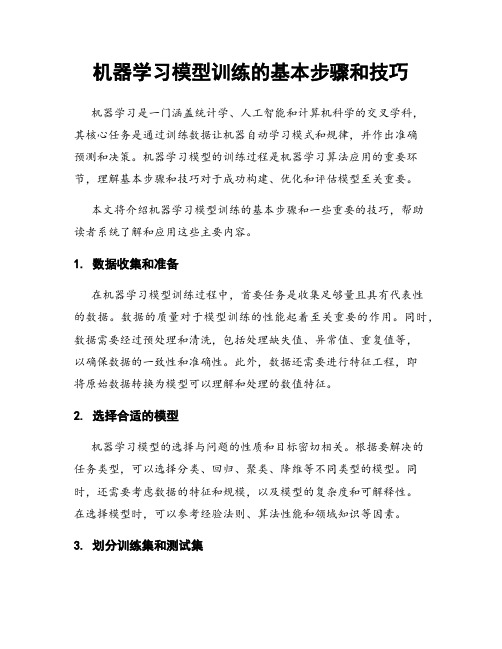
机器学习模型训练的基本步骤和技巧机器学习是一门涵盖统计学、人工智能和计算机科学的交叉学科,其核心任务是通过训练数据让机器自动学习模式和规律,并作出准确预测和决策。
机器学习模型的训练过程是机器学习算法应用的重要环节,理解基本步骤和技巧对于成功构建、优化和评估模型至关重要。
本文将介绍机器学习模型训练的基本步骤和一些重要的技巧,帮助读者系统了解和应用这些主要内容。
1. 数据收集和准备在机器学习模型训练过程中,首要任务是收集足够量且具有代表性的数据。
数据的质量对于模型训练的性能起着至关重要的作用。
同时,数据需要经过预处理和清洗,包括处理缺失值、异常值、重复值等,以确保数据的一致性和准确性。
此外,数据还需要进行特征工程,即将原始数据转换为模型可以理解和处理的数值特征。
2. 选择合适的模型机器学习模型的选择与问题的性质和目标密切相关。
根据要解决的任务类型,可以选择分类、回归、聚类、降维等不同类型的模型。
同时,还需要考虑数据的特征和规模,以及模型的复杂度和可解释性。
在选择模型时,可以参考经验法则、算法性能和领域知识等因素。
3. 划分训练集和测试集为了评估模型的性能和泛化能力,需要将收集到的数据集划分为训练集和测试集。
训练集用于模型的参数学习和调整,而测试集则用于模型的评估。
常用的划分方法是随机划分和交叉验证,确保训练集和测试集之间的独立性和代表性。
4. 模型训练和优化在训练过程中,根据选择的模型和优化算法,通过最小化损失函数来调整模型的参数。
常见的优化算法包括梯度下降、随机梯度下降和牛顿法等。
为了提高模型的性能和泛化能力,需要进行超参数调优,包括学习率、正则化参数等。
此外,还可以采用集成学习、特征选择和模型融合等技巧来优化模型的性能。
5. 模型评估和验证模型在训练集上的表现并不能完全代表其在实际应用中的性能。
因此,在模型训练完成后,需要使用测试集来对模型进行评估和验证。
常见的评估指标包括准确率、召回率、F1值、均方误差和对数损失等。
机器学习算法在财务分析中的应用
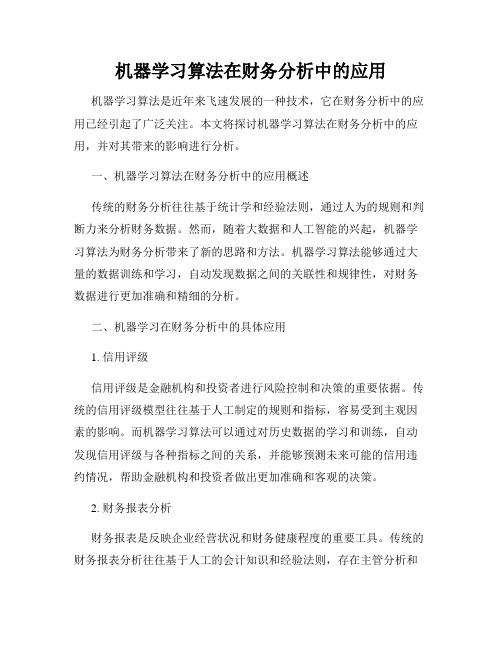
机器学习算法在财务分析中的应用机器学习算法是近年来飞速发展的一种技术,它在财务分析中的应用已经引起了广泛关注。
本文将探讨机器学习算法在财务分析中的应用,并对其带来的影响进行分析。
一、机器学习算法在财务分析中的应用概述传统的财务分析往往基于统计学和经验法则,通过人为的规则和判断力来分析财务数据。
然而,随着大数据和人工智能的兴起,机器学习算法为财务分析带来了新的思路和方法。
机器学习算法能够通过大量的数据训练和学习,自动发现数据之间的关联性和规律性,对财务数据进行更加准确和精细的分析。
二、机器学习在财务分析中的具体应用1. 信用评级信用评级是金融机构和投资者进行风险控制和决策的重要依据。
传统的信用评级模型往往基于人工制定的规则和指标,容易受到主观因素的影响。
而机器学习算法可以通过对历史数据的学习和训练,自动发现信用评级与各种指标之间的关系,并能够预测未来可能的信用违约情况,帮助金融机构和投资者做出更加准确和客观的决策。
2. 财务报表分析财务报表是反映企业经营状况和财务健康程度的重要工具。
传统的财务报表分析往往基于人工的会计知识和经验法则,存在主管分析和信息难以获取的问题。
而机器学习算法可以通过对大量财务报表数据的学习和训练,自动分析和提取关键信息,快速识别异常情况和潜在风险,并能够根据不同行业和公司的特点进行个性化分析,为决策者提供更加全面和准确的财务数据。
3. 股票预测股票市场是一个充满不确定性和波动性的领域,传统的股票预测方法往往依赖于技术分析和基本面分析,存在较大的局限性。
而机器学习算法可以通过对历史股票数据的学习和训练,挖掘出具有预测价值的特征和模式,从而预测股票价格的走势。
通过机器学习算法的应用,投资者可以更好地制定投资策略和风险管理方法。
三、机器学习算法在财务分析中的优势1. 数据驱动机器学习算法是一种数据驱动的分析方法,可以从大量的历史数据中学习和发现规律性和关联性。
相比传统的人工分析方法,机器学习算法能够更加客观和准确地对财务数据进行分析和预测。
机器学习在药物设计与发现中的应用与挑战
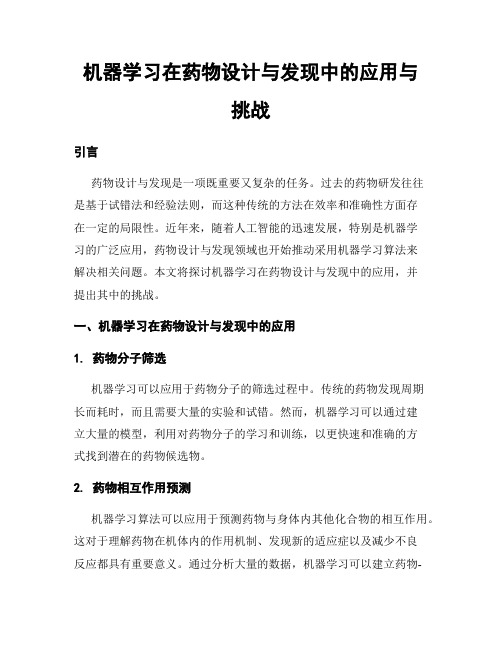
机器学习在药物设计与发现中的应用与挑战引言药物设计与发现是一项既重要又复杂的任务。
过去的药物研发往往是基于试错法和经验法则,而这种传统的方法在效率和准确性方面存在一定的局限性。
近年来,随着人工智能的迅速发展,特别是机器学习的广泛应用,药物设计与发现领域也开始推动采用机器学习算法来解决相关问题。
本文将探讨机器学习在药物设计与发现中的应用,并提出其中的挑战。
一、机器学习在药物设计与发现中的应用1. 药物分子筛选机器学习可以应用于药物分子的筛选过程中。
传统的药物发现周期长而耗时,而且需要大量的实验和试错。
然而,机器学习可以通过建立大量的模型,利用对药物分子的学习和训练,以更快速和准确的方式找到潜在的药物候选物。
2. 药物相互作用预测机器学习算法可以应用于预测药物与身体内其他化合物的相互作用。
这对于理解药物在机体内的作用机制、发现新的适应症以及减少不良反应都具有重要意义。
通过分析大量的数据,机器学习可以建立药物-蛋白质、药物-基因和药物-细胞等相互作用模型,从而为药物设计和个体化治疗提供有力的支持。
3. 药物剂量优化机器学习可以帮助优化药物剂量,以提高治疗效果和减少不良反应。
通过基于患者特征和药物代谢动力学等数据构建模型,机器学习可以预测最佳的药物剂量范围,并进行个体化的调整,从而使治疗更加精确和有效。
4. 药物不良反应预测药物不良反应是药物研发和使用过程中需要高度关注和解决的问题。
机器学习可应用于预测和评估药物的不良反应风险。
通过建立与药物不良反应相关的数据模型,机器学习可以识别潜在风险因素,提前预警和避免不良反应的发生。
二、机器学习在药物设计与发现中的挑战1. 数据获取与质量机器学习算法对大规模、高质量的数据依赖性很高。
然而,药物领域的数据往往供不应求,特别是临床试验数据。
此外,药物相关数据的质量也是一个挑战,因为很多数据是不完整或不准确的,这可能会影响模型的准确性和可靠性。
2. 特征工程机器学习算法对于提取和选择合适的特征非常重要。
机器学习的四十三条经验法则全文
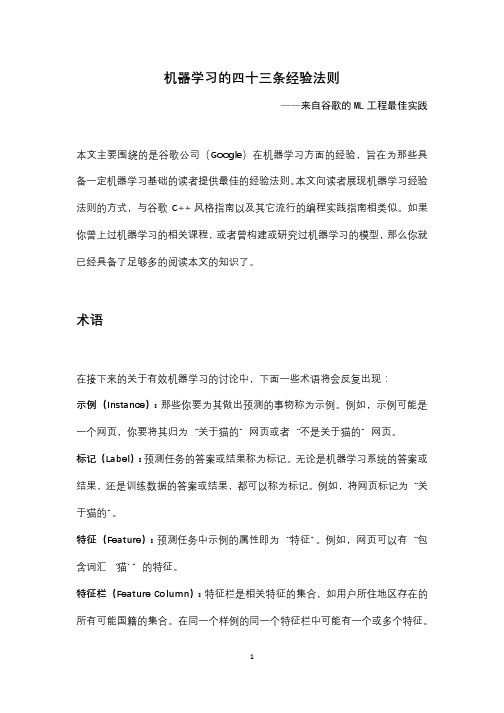
机器学习的四十三条经验法则——来自谷歌的ML工程最佳实践本文主要围绕的是谷歌公司(Google)在机器学习方面的经验,旨在为那些具备一定机器学习基础的读者提供最佳的经验法则。
本文向读者展现机器学习经验法则的方式,与谷歌C++ 风格指南以及其它流行的编程实践指南相类似。
如果你曾上过机器学习的相关课程,或者曾构建或研究过机器学习的模型,那么你就已经具备了足够多的阅读本文的知识了。
术语在接下来的关于有效机器学习的讨论中,下面一些术语将会反复出现:示例(Instance):那些你要为其做出预测的事物称为示例。
例如,示例可能是一个网页,你要将其归为“关于猫的”网页或者“不是关于猫的”网页。
标记(Label):预测任务的答案或结果称为标记。
无论是机器学习系统的答案或结果,还是训练数据的答案或结果,都可以称为标记。
例如,将网页标记为“关于猫的”。
特征(Feature):预测任务中示例的属性即为“特征”。
例如,网页可以有“包含词汇‘猫’”的特征。
特征栏(Feature Column):特征栏是相关特征的集合,如用户所住地区存在的所有可能国籍的集合。
在同一个样例的同一个特征栏中可能有一个或多个特征。
特征栏相当于(雅虎或微软的)虚拟机系统的“命名空间(namespace)”或“域(field)”。
样例(Example):样例包含示例(具有各种特征)和标记。
模型(Model):模型是预测任务的数学表达形式。
先是通过样例训练模型,而后利用模型做出预测。
度量(Metric):度量是指一系列的数字,这些数字直接或间接的都被优化过。
目标(Objective):目标是指算法经过优化,努力要达到的度量标准。
工作流(Pipeline):工作流指的是围绕机器学习算法而存在的基础架构。
从前端搜集数据、将搜集到的数据放入训练数据文件夹、训练一个或多个模型以及将模型用于生产等过程,都属于工作流。
综述要想创造出优秀的产品:你需要以一位优秀工程师的身份去运用深度学习!记住!你不单单是一位机器学习的研究者!事实上,你所面临的大多数问题都是技术性问题。
CSharp Language Specification

C#语言规范版本4.0版权所有 Microsoft C orporation 1999-2010。
保留所有权利。
目录目录1. 简介 (1)1.1 Hello world (1)1.2 程序结构 (2)1.3 类型和变量 (3)1.4 表达式 (6)1.5 语句 (8)1.6 类和对象 (12)1.6.1 成员 (12)1.6.2 可访问性 (13)1.6.3 类型参数 (13)1.6.4 基类 (14)1.6.5 字段 (14)1.6.6 方法 (15)1.6.6.1 参数 (15)1.6.6.2 方法体和局部变量 (17)1.6.6.3 静态方法和实例方法 (17)1.6.6.4 虚方法、重写方法和抽象方法 (18)1.6.6.5 方法重载 (20)1.6.7 其他函数成员 (21)1.6.7.1 构造函数 (22)1.6.7.2 属性 (23)1.6.7.3 索引器 (23)1.6.7.4 事件 (23)1.6.7.5 运算符 (24)1.6.7.6 析构函数 (25)1.7 结构 (25)1.8 数组 (26)1.9 接口 (27)1.10 枚举 (28)1.11 委托 (29)1.12 特性 (30)2. 词法结构 (33)2.1 程序 (33)2.2 文法 (33)2.2.1 文法表示法 (33)2.2.2 词法文法 (34)2.2.3 句法文法 (34)2.3 词法分析 (34)2.3.1 行结束符 (35)2.3.2 注释 (35)2.3.3 空白 (36)2.4 标记 (37)2.4.1 Unicode 字符转义序列 (37)C# 语言规范2.4.2 标识符 (38)2.4.3 关键字 (39)2.4.4 文本 (41)2.4.4.1 布尔值 (41)2.4.4.2 整数 (41)2.4.4.3 实数 (42)2.4.4.4 字符 (43)2.4.4.5 字符串 (44)2.4.4.6 null 文本 (46)2.4.5 运算符和标点符号 (46)2.5 预处理指令 (46)2.5.1 条件编译符号 (47)2.5.2 预处理表达式 (48)2.5.3 声明指令 (49)2.5.4 条件编译指令 (49)2.5.5 诊断指令 (52)2.5.6 区域指令 (52)2.5.7 行指令 (53)2.5.8 Pragma 指令 (53)2.5.8.1 Pragma warning (54)3. 基本概念 (55)3.1 应用程序启动 (55)3.2 应用程序终止 (56)3.3 声明 (56)3.4 成员 (58)3.4.1 命名空间成员 (58)3.4.2 结构成员 (59)3.4.3 枚举成员 (59)3.4.4 类成员 (59)3.4.5 接口成员 (59)3.4.6 数组成员 (60)3.4.7 委托成员 (60)3.5 成员访问 (60)3.5.1 已声明可访问性 (60)3.5.2 可访问域 (61)3.5.3 实例成员的受保护访问 (63)3.5.4 可访问性约束 (64)3.6 签名和重载 (65)3.7 范围 (66)3.7.1 名称隐藏 (68)3.7.1.1 通过嵌套隐藏 (68)3.7.1.2 通过继承隐藏 (69)3.8 命名空间和类型名称 (70)3.8.1 完全限定名 (72)目录3.9 自动内存管理 (73)3.10 执行顺序 (75)4. 类型 (77)4.1 值类型 (77)4.1.1 System.ValueType 类型 (78)4.1.2 默认构造函数 (78)4.1.3 结构类型 (79)4.1.4 简单类型 (79)4.1.5 整型 (80)4.1.6 浮点型 (81)4.1.7 decimal 类型 (82)4.1.8 bool 类型 (82)4.1.9 枚举类型 (82)4.1.10 可以为 null 的类型 (83)4.2 引用类型 (83)4.2.1 类类型 (84)4.2.2 对象类型 (84)4.2.3 dynamic 类型 (84)4.2.4 string 类型 (85)4.2.5 接口类型 (85)4.2.6 数组类型 (85)4.2.7 委托类型 (85)4.3 装箱和拆箱 (85)4.3.1 装箱转换 (85)4.3.2 拆箱转换 (87)4.4 构造类型 (87)4.4.1 类型实参 (88)4.4.2 开放和封闭类型 (88)4.4.3 绑定和未绑定类型 (89)4.4.4 满足约束 (89)4.5 类型形参 (90)4.6 表达式树类型 (91)4.7 dynamic 类型 (91)5. 变量 (93)5.1 变量类别 (93)5.1.1 静态变量 (93)5.1.2 实例变量 (93)5.1.2.1 类中的实例变量 (93)5.1.2.2 结构中的实例变量 (94)5.1.3 数组元素 (94)5.1.4 值参数 (94)5.1.5 引用形参 (94)5.1.6 输出形参 (94)5.1.7 局部变量 (95)C# 语言规范5.2 默认值 (95)5.3 明确赋值 (96)5.3.1 初始已赋值变量 (96)5.3.2 初始未赋值变量 (97)5.3.3 确定明确赋值的细则 (97)5.3.3.1 一般语句规则 (98)5.3.3.2 块语句、checked 和 unchecked 语句 (98)5.3.3.3 表达式语句 (98)5.3.3.4 声明语句 (98)5.3.3.5 if 语句 (98)5.3.3.6 switch 语句 (99)5.3.3.7 while 语句 (99)5.3.3.8 do 语句 (99)5.3.3.9 for 语句 (99)5.3.3.10 break、continue 和 goto 语句 (100)5.3.3.11 throw 语句 (100)5.3.3.12 return 语句 (100)5.3.3.13 try-catch 语句 (100)5.3.3.14 try-finally 语句 (100)5.3.3.15 try-catch-finally 语句 (101)5.3.3.16 foreach 语句 (102)5.3.3.17 using 语句 (102)5.3.3.18 lock 语句 (102)5.3.3.19 yield 语句 (102)5.3.3.20 简单表达式的一般规则 (102)5.3.3.21 带有嵌入表达式的表达式的一般规则 (103)5.3.3.22 调用表达式和对象创建表达式 (103)5.3.3.23 简单赋值表达式 (103)5.3.3.24 && 表达式 (104)5.3.3.25 || 表达式 (104)5.3.3.26 ! 表达式 (105)5.3.3.27 ?? 表达式 (105)5.3.3.28 ?: 表达式 (106)5.3.3.29 匿名函数 (106)5.4 变量引用 (107)5.5 变量引用的原子性 (107)6. 转换 (109)6.1 隐式转换 (109)6.1.1 标识转换 (110)6.1.2 隐式数值转换 (110)6.1.3 隐式枚举转换 (110)6.1.4 可以为 null 的隐式转换 (110)6.1.5 null 文本转换 (111)6.1.6 隐式引用转换 (111)目录6.1.7 装箱转换 (111)6.1.8 隐式动态转换 (112)6.1.9 隐式常量表达式转换 (112)6.1.10 涉及类型形参的隐式转换 (112)6.1.11 用户定义的隐式转换 (113)6.1.12 匿名函数转换和方法组转换 (113)6.2 显式转换 (113)6.2.1 显式数值转换 (114)6.2.2 显式枚举转换 (115)6.2.3 可以为 null 的显式转换 (115)6.2.4 显式引用转换 (116)6.2.5 拆箱转换 (117)6.2.6 显式动态转换 (117)6.2.7 涉及类型形参的显式转换 (118)6.2.8 用户定义的显式转换 (118)6.3 标准转换 (119)6.3.1 标准隐式转换 (119)6.3.2 标准显式转换 (119)6.4 用户定义的转换 (119)6.4.1 允许的用户定义转换 (119)6.4.2 提升转换运算符 (119)6.4.3 用户定义转换的计算 (120)6.4.4 用户定义的隐式转换 (120)6.4.5 用户定义的显式转换 (121)6.5 匿名函数转换 (122)6.5.1 匿名函数转换为委托类型的计算 (123)6.5.2 匿名函数转换为表达式树类型的计算 (124)6.5.3 实现示例 (124)6.6 方法组转换 (126)7. 表达式 (129)7.1 表达式的分类 (129)7.1.1 表达式的值 (130)7.2 静态和动态绑定 (130)7.2.1 绑定时间 (131)7.2.2 动态绑定 (131)7.2.3 构成表达式的类型 (131)7.3 运算符 (131)7.3.1 运算符的优先级和顺序关联性 (132)7.3.2 运算符重载 (133)7.3.3 一元运算符重载决策 (134)7.3.4 二元运算符重载决策 (134)7.3.5 候选用户定义运算符 (134)7.3.6 数值提升 (135)7.3.6.1 一元数值提升 (135)C# 语言规范7.3.6.2 二元数值提升 (135)7.3.7 提升运算符 (136)7.4 成员查找 (137)7.4.1 基类型 (138)7.5 函数成员 (138)7.5.1 实参列表 (140)7.5.1.1 对应形参 (141)7.5.1.2 实参列表的运行时计算 (142)7.5.2 类型推断 (143)7.5.2.1 第一阶段 (144)7.5.2.2 第二阶段 (144)7.5.2.3 输入类型 (144)7.5.2.4 输出类型 (145)7.5.2.5 依赖 (145)7.5.2.6 输出类型推断 (145)7.5.2.7 参数类型显式推断 (145)7.5.2.8 精确推断 (145)7.5.2.9 下限推断 (145)7.5.2.10 上限推断 (146)7.5.2.11 固定 (147)7.5.2.12 推断返回类型 (147)7.5.2.13 方法组转换的类型推断 (148)7.5.2.14 查找一组表达式的最通用类型 (148)7.5.3 重载决策 (149)7.5.3.1 适用函数成员 (149)7.5.3.2 更好的函数成员 (150)7.5.3.3 表达式的更佳转换 (151)7.5.3.4 类型的更佳转换 (151)7.5.3.5 更佳转换目标 (151)7.5.3.6 泛型类中的重载 (151)7.5.4 动态重载决策的编译时检查 (152)7.5.5 函数成员调用 (152)7.5.5.1 已装箱实例上的调用 (153)7.6 基本表达式 (154)7.6.1 文本 (154)7.6.2 简单名称 (154)7.6.2.1 块中的固定含义 (155)7.6.3 带括号的表达式 (156)7.6.4 成员访问 (157)7.6.4.1 相同的简单名称和类型名称 (158)7.6.4.2 语法多义性 (159)7.6.5 调用表达式 (159)7.6.5.1 方法调用 (160)7.6.5.2 扩展方法调用 (161)7.6.5.3 委托调用 (163)目录7.6.6 元素访问 (164)7.6.6.1 数组访问 (164)7.6.6.2 索引器访问 (165)7.6.7 this 访问 (165)7.6.8 基访问 (166)7.6.9 后缀增量和后缀减量运算符 (166)7.6.10 new 运算符 (167)7.6.10.1 对象创建表达式 (168)7.6.10.2 对象初始值设定项 (169)7.6.10.3 集合初始值设定项 (171)7.6.10.4 数组创建表达式 (172)7.6.10.5 委托创建表达式 (174)7.6.10.6 匿名对象创建表达式 (175)7.6.11 typeof 运算符 (177)7.6.12 checked 和 unchecked 运算符 (178)7.6.13 默认值表达式 (180)7.6.14 匿名方法表达式 (181)7.7 一元运算符 (181)7.7.1 一元加运算符 (181)7.7.2 一元减运算符 (181)7.7.3 逻辑否定运算符 (182)7.7.4 按位求补运算符 (182)7.7.5 前缀增量和减量运算符 (182)7.7.6 强制转换表达式 (183)7.8 算术运算符 (184)7.8.1 乘法运算符 (184)7.8.2 除法运算符 (185)7.8.3 余数运算符 (186)7.8.4 加法运算符 (187)7.8.5 减法运算符 (189)7.9 移位运算符 (190)7.10 关系和类型测试运算符 (192)7.10.1 整数比较运算符 (192)7.10.2 浮点比较运算符 (193)7.10.3 小数比较运算符 (194)7.10.4 布尔相等运算符 (194)7.10.5 枚举比较运算符 (194)7.10.6 引用类型相等运算符 (194)7.10.7 字符串相等运算符 (196)7.10.8 委托相等运算符 (196)7.10.9 相等运算符和 null (197)7.10.10 is 运算符 (197)7.10.11 as 运算符 (197)7.11 逻辑运算符 (198)7.11.1 整数逻辑运算符 (199)C# 语言规范7.11.2 枚举逻辑运算符 (199)7.11.3 布尔逻辑运算符 (199)7.11.4 可以为 null 的布尔逻辑运算符 (199)7.12 条件逻辑运算符 (200)7.12.1 布尔条件逻辑运算符 (200)7.12.2 用户定义的条件逻辑运算符 (201)7.13 空合并运算符 (201)7.14 条件运算符 (202)7.15 匿名函数表达式 (203)7.15.1 匿名函数签名 (204)7.15.2 匿名函数体 (205)7.15.3 重载决策 (205)7.15.4 匿名函数与动态绑定 (206)7.15.5 外层变量 (206)7.15.5.1 捕获的外层变量 (206)7.15.5.2 局部变量实例化 (207)7.15.6 匿名函数表达式计算 (209)7.16 查询表达式 (209)7.16.1 查询表达式的多义性 (210)7.16.2 查询表达式转换 (210)7.16.2.1 带继续符的 select 和 groupby 子句 (211)7.16.2.2 显式范围变量类型 (211)7.16.2.3 退化查询表达式 (212)7.16.2.4 from、let、where、join 和 orderby 子句 (212)7.16.2.5 select 子句 (216)7.16.2.6 Groupby 子句 (216)7.16.2.7 透明标识符 (216)7.16.3 查询表达式模式 (218)7.17 赋值运算符 (219)7.17.1 简单赋值 (219)7.17.2 复合赋值 (221)7.17.3 事件赋值 (222)7.18 表达式 (222)7.19 常量表达式 (223)7.20 布尔表达式 (224)8. 语句 (225)8.1 结束点和可到达性 (225)8.2 块 (227)8.2.1 语句列表 (227)8.3 空语句 (228)8.4 标记语句 (228)8.5 声明语句 (229)8.5.1 局部变量声明 (229)8.5.2 局部常量声明 (230)目录8.6 表达式语句 (231)8.7 选择语句 (231)8.7.1 if 语句 (231)8.7.2 switch 语句 (232)8.8 迭代语句 (236)8.8.1 while 语句 (236)8.8.2 do 语句 (236)8.8.3 for 语句 (237)8.8.4 foreach 语句 (238)8.9 跳转语句 (240)8.9.1 break 语句 (241)8.9.2 continue 语句 (242)8.9.3 goto 语句 (242)8.9.4 return 语句 (243)8.9.5 throw 语句 (244)8.10 try 语句 (245)8.11 checked 语句和 unchecked 语句 (247)8.12 lock 语句 (248)8.13 using 语句 (248)8.14 yield 语句 (250)9. 命名空间 (253)9.1 编译单元 (253)9.2 命名空间声明 (253)9.3 Extern 别名 (254)9.4 using 指令 (255)9.4.1 using 别名指令 (255)9.4.2 Using 命名空间指令 (258)9.5 命名空间成员 (260)9.6 类型声明 (260)9.7 命名空间别名限定符 (261)9.7.1 别名的唯一性 (262)10. 类 (263)10.1 类声明 (263)10.1.1 类修饰符 (263)10.1.1.1 抽象类 (264)10.1.1.2 密封类 (264)10.1.1.3 静态类 (264)10.1.2 分部修饰符 (265)10.1.3 类型形参 (265)10.1.4 类基本规范 (266)10.1.4.1 基类 (266)10.1.4.2 接口实现 (267)10.1.5 类型形参约束 (268)10.1.6 类体 (272)C# 语言规范10.2 分部类型 (272)10.2.1 特性 (272)10.2.2 修饰符 (273)10.2.3 类型形参和约束 (273)10.2.4 基类 (273)10.2.5 基接口 (274)10.2.6 成员 (274)10.2.7 分部方法 (275)10.2.8 名称绑定 (277)10.3 类成员 (277)10.3.1 实例类型 (278)10.3.2 构造类型的成员 (279)10.3.3 继承 (280)10.3.4 new 修饰符 (280)10.3.5 访问修饰符 (281)10.3.6 构成类型 (281)10.3.7 静态成员和实例成员 (281)10.3.8 嵌套类型 (282)10.3.8.1 完全限定名 (282)10.3.8.2 已声明可访问性 (282)10.3.8.3 隐藏 (283)10.3.8.4 this 访问 (283)10.3.8.5 对包含类型的私有和受保护成员的访问 (284)10.3.8.6 泛型类中的嵌套类型 (285)10.3.9 保留成员名称 (286)10.3.9.1 为属性保留的成员名称 (286)10.3.9.2 为事件保留的成员名称 (287)10.3.9.3 为索引器保留的成员名称 (287)10.3.9.4 为析构函数保留的成员名称 (287)10.4 常量 (287)10.5 字段 (289)10.5.1 静态字段和实例字段 (290)10.5.2 只读字段 (291)10.5.2.1 对常量使用静态只读字段 (291)10.5.2.2 常量和静态只读字段的版本控制 (291)10.5.3 可变字段 (292)10.5.4 字段初始化 (293)10.5.5 变量初始值设定项 (293)10.5.5.1 静态字段初始化 (294)10.5.5.2 实例字段初始化 (295)10.6 方法 (296)10.6.1 方法形参 (298)10.6.1.1 值参数 (299)10.6.1.2 引用形参 (299)10.6.1.3 输出形参 (300)目录10.6.1.4 形参数组 (301)10.6.2 静态方法和实例方法 (303)10.6.3 虚方法 (304)10.6.4 重写方法 (305)10.6.5 密封方法 (307)10.6.6 抽象方法 (308)10.6.7 外部方法 (309)10.6.8 分部方法 (310)10.6.9 扩展方法 (310)10.6.10 方法体 (311)10.6.11 方法重载 (311)10.7 属性 (311)10.7.1 静态属性和实例属性 (312)10.7.2 访问器 (313)10.7.3 自动实现的属性 (317)10.7.4 可访问性 (318)10.7.5 虚、密封、重写和抽象访问器 (319)10.8 事件 (321)10.8.1 类似字段的事件 (323)10.8.2 事件访问器 (324)10.8.3 静态事件和实例事件 (325)10.8.4 虚、密封、重写和抽象访问器 (325)10.9 索引器 (326)10.9.1 索引器重载 (329)10.10 运算符 (329)10.10.1 一元运算符 (331)10.10.2 二元运算符 (331)10.10.3 转换运算符 (332)10.11 实例构造函数 (334)10.11.1 构造函数初始值设定项 (335)10.11.2 实例变量初始值设定项 (336)10.11.3 构造函数执行 (336)10.11.4 默认构造函数 (338)10.11.5 私有构造函数 (338)10.11.6 可选的实例构造函数形参 (339)10.12 静态构造函数 (339)10.13 析构函数 (341)10.14 迭代器 (343)10.14.1 枚举器接口 (343)10.14.2 可枚举接口 (343)10.14.3 产生类型 (343)10.14.4 枚举器对象 (343)10.14.4.1 MoveNext 方法 (344)10.14.4.2 Current 属性 (345)10.14.4.3 Dispose 方法 (345)C# 语言规范10.14.5 可枚举对象 (345)10.14.5.1 GetEnumerator 方法 (346)10.14.6 实现示例 (346)11. 结构 (353)11.1 结构声明 (353)11.1.1 结构修饰符 (353)11.1.2 分部修饰符 (353)11.1.3 结构接口 (354)11.1.4 结构体 (354)11.2 结构成员 (354)11.3 类和结构的区别 (354)11.3.1 值语义 (355)11.3.2 继承 (355)11.3.3 赋值 (356)11.3.4 默认值 (356)11.3.5 装箱和拆箱 (356)11.3.6 this 的含义 (358)11.3.7 字段初始值设定项 (358)11.3.8 构造函数 (358)11.3.9 析构函数 (359)11.3.10 静态构造函数 (359)11.4 结构示例 (360)11.4.1 数据库整数类型 (360)11.4.2 数据库布尔类型 (361)12. 数组 (365)12.1 数组类型 (365)12.1.1 System.Array 类型 (366)12.1.2 数组和泛型 IList 接口 (366)12.2 数组创建 (366)12.3 数组元素访问 (367)12.4 数组成员 (367)12.5 数组协变 (367)12.6 数组初始值设定项 (367)13. 接口 (369)13.1 接口声明 (369)13.1.1 接口修饰符 (369)13.1.2 分部修饰符 (369)13.1.3 Variant 类型形参列表 (370)13.1.3.1 变化安全性 (370)13.1.3.2 变化转换 (371)13.1.4 基接口 (371)13.1.5 接口体 (372)13.2 接口成员 (372)目录13.2.1 接口方法 (373)13.2.2 接口属性 (373)13.2.3 接口事件 (374)13.2.4 接口索引器 (374)13.2.5 接口成员访问 (374)13.3 完全限定接口成员名 (376)13.4 接口实现 (376)13.4.1 显式接口成员实现 (377)13.4.2 所实现接口的唯一性 (379)13.4.3 泛型方法实现 (380)13.4.4 接口映射 (381)13.4.5 接口实现继承 (383)13.4.6 接口重新实现 (385)13.4.7 抽象类和接口 (386)14. 枚举 (387)14.1 枚举声明 (387)14.2 枚举修饰符 (387)14.3 枚举成员 (388)14.4 System.Enum 类型 (390)14.5 枚举值和运算 (390)15. 委托 (391)15.1 委托声明 (391)15.2 委托兼容性 (393)15.3 委托实例化 (393)15.4 委托调用 (394)16. 异常 (397)16.1 导致异常的原因 (397)16.2 System.Exception 类 (397)16.3 异常的处理方式 (397)16.4 公共异常类 (398)17. 特性 (399)17.1 特性类 (399)17.1.1 特性用法 (399)17.1.2 定位和命名参数 (400)17.1.3 特性参数类型 (401)17.2 特性说明 (401)17.3 特性实例 (406)17.3.1 特性的编译 (406)17.3.2 特性实例的运行时检索 (406)17.4 保留特性 (407)17.4.1 AttributeUsage 特性 (407)17.4.2 Conditional 特性 (408)C# 语言规范17.4.2.1 条件方法 (408)17.4.2.2 条件特性类 (410)17.4.3 Obsolete 特性 (411)17.5 互操作的特性 (412)17.5.1 与 COM 和 Win32 组件的互操作 (412)17.5.2 与其他 .NET 语言的互操作 (412)17.5.2.1 IndexerName 特性 (412)18. 不安全代码 (413)18.1 不安全上下文 (413)18.2 指针类型 (415)18.3 固定和可移动变量 (418)18.4 指针转换 (418)18.4.1 指针数组 (419)18.5 表达式中的指针 (420)18.5.1 指针间接寻址 (420)18.5.2 指针成员访问 (421)18.5.3 指针元素访问 (422)18.5.4 address-of 运算符 (422)18.5.5 指针递增和递减 (423)18.5.6 指针算术运算 (423)18.5.7 指针比较 (424)18.5.8 sizeof 运算符 (425)18.6 fixed 语句 (425)18.7 固定大小缓冲区 (429)18.7.1 固定大小缓冲区的声明 (429)18.7.2 表达式中的固定大小缓冲区 (430)18.7.3 明确赋值检查 (431)18.8 堆栈分配 (431)18.9 动态内存分配 (432)A. 文档注释 (435)A.1 简介 (435)A.2 建议的标记 (436)A.2.1 <c> (437)A.2.2 <code> (437)A.2.3 <example> (437)A.2.4 <exception> (438)A.2.5 <include> (438)A.2.6 <list> (439)A.2.7 <para> (440)A.2.8 <param> (440)A.2.9 <paramref> (441)A.2.10 <permission> (441)A.2.11 <remark> (441)A.2.12 <returns> (442)A.2.13 <see> (442)目录A.2.14 <seealso> (443)A.2.15 <summary> (443)A.2.16 <value> (443)A.2.17 <typeparam> (444)A.2.18 <typeparamref> (444)A.3 处理文档文件 (445)A.3.1 ID 字符串格式 (445)A.3.2 ID 字符串示例 (446)A.4 示例 (449)A.4.1 C# 源代码 (449)A.4.2 生成 XML (452)B. 语法 (455)B.1 词法文法 (455)B.1.1 行结束符 (455)B.1.2 注释 (455)B.1.3 空白 (456)B.1.4 标记 (456)B.1.5 Unicode 字符转义序列 (456)B.1.6 标识符 (456)B.1.7 关键字 (458)B.1.8 文本 (458)B.1.9 运算符和标点符号 (460)B.1.10 预处理指令 (460)B.2 句法文法 (463)B.2.1 基本概念 (463)B.2.2 类型 (463)B.2.3 变量 (464)B.2.4 表达式 (464)B.2.5 语句 (471)B.2.6 命名空间 (475)B.2.7 类 (475)B.2.8 结构 (483)B.2.9 数组 (483)B.2.10 接口 (484)B.2.11 枚举 (485)B.2.12 委托 (486)B.2.13 特性 (486)B.3 不安全代码的语法扩展 (487)C. 参考资料 (491)第错误!使用“开始”选项卡将 Heading 1 应用于要在此处显示的文字。
机器学习的模型选择

机器学习的模型选择机器学习作为一种重要的技术手段,正在在各个领域发挥着巨大的作用。
而在机器学习的实践中,模型选择是一个至关重要的环节。
选择合适的模型可以有效提高机器学习的准确性和性能。
本文将讨论机器学习的模型选择问题,并介绍一些常用的模型选择方法。
一、模型选择的重要性模型选择是机器学习中的关键环节之一。
不同的模型具有不同的复杂性和学习能力,选择合适的模型能够更好地适应数据集,并取得更好的性能。
而选择不合适的模型可能导致欠拟合或过拟合等问题,影响机器学习的效果。
二、常用的模型选择方法1. 经验法则在实际应用中,有一些经验法则可供参考。
例如,在处理分类问题时,可以首先尝试逻辑回归模型或支持向量机模型;在处理回归问题时,可以尝试线性回归模型或决策树模型。
这些经验法则可以作为模型选择的起点,但并不适用于所有场景,因此需要根据具体问题调整和改进。
2. 交叉验证交叉验证是一种常用的模型选择方法。
它将数据集划分为训练集和验证集,然后使用不同的模型对训练集进行训练,并在验证集上进行评估。
通过比较不同模型在验证集上的表现,选择性能最好的模型作为最终的选择。
常见的交叉验证方法包括k折交叉验证和留一交叉验证。
3. 模型评估指标模型评估指标是衡量模型性能的重要依据。
常用的评估指标包括准确率、精确度、召回率、F1分数等。
在模型选择过程中,可以根据不同的问题需求选择相应的评估指标,综合考虑模型在不同指标上的表现,选择最合适的模型。
4. 集成学习集成学习是一种将多个基本模型组合起来进行学习和预测的方法。
通过将多个模型进行集成,可以有效地提高模型的性能和鲁棒性。
常见的集成学习方法有随机森林、梯度提升树等。
在模型选择中,可以考虑尝试集成学习方法,以期获得更好的结果。
三、模型选择的注意事项1. 考虑问题的特征在进行模型选择时,需要充分考虑问题的特征。
例如,数据是否具有线性关系、是否存在非线性关系、数据量大小等因素都会影响模型的选择。
机器学习中的有监督学习,无监督学习,半监督学习

机器学习中的有监督学习,⽆监督学习,半监督学习在机器学习(Machine learning)领域。
主要有三类不同的学习⽅法:监督学习(Supervised learning)、⾮监督学习(Unsupervised learning)、半监督学习(Semi-supervised learning),监督学习:通过已有的⼀部分输⼊数据与输出数据之间的相应关系。
⽣成⼀个函数,将输⼊映射到合适的输出,⽐如分类。
⾮监督学习:直接对输⼊数据集进⾏建模,⽐如聚类。
半监督学习:综合利⽤有类标的数据和没有类标的数据,来⽣成合适的分类函数。
⼀、监督学习1、监督式学习(Supervised learning),是⼀个机器学习中的⽅法。
能够由训练资料中学到或建⽴⼀个模式( learning model)。
并依此模式猜測新的实例。
训练资料是由输⼊物件(⼀般是向量)和预期输出所组成。
函数的输出能够是⼀个连续的值(称为回归分析)。
或是预測⼀个分类标签(称作分类)。
2、⼀个监督式学习者的任务在观察完⼀些训练范例(输⼊和预期输出)后,去预測这个函数对不论什么可能出现的输⼊的值的输出。
要达到此⽬的。
学习者必须以"合理"(见归纳偏向)的⽅式从现有的资料中⼀般化到⾮观察到的情况。
在⼈类和动物感知中。
则通常被称为概念学习(concept learning)。
3、监督式学习有两种形态的模型。
最⼀般的。
监督式学习产⽣⼀个全域模型,会将输⼊物件相应到预期输出。
⽽还有⼀种,则是将这样的相应实作在⼀个区域模型。
(如案例推论及近期邻居法)。
为了解决⼀个给定的监督式学习的问题(⼿写辨识),必须考虑下⾯步骤:1)决定训练资料的范例的形态。
在做其他事前,project师应决定要使⽤哪种资料为范例。
譬如,可能是⼀个⼿写字符,或⼀整个⼿写的词汇。
或⼀⾏⼿写⽂字。
2)搜集训练资料。
这资料需要具有真实世界的特征。
所以。
能够由⼈类专家或(机器或传感器的)測量中得到输⼊物件和其相相应输出。
3 sigma原则
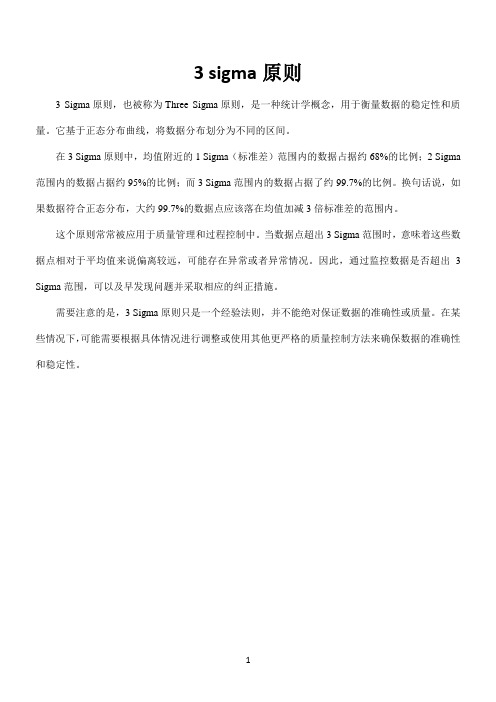
3 sigma原则
3 Sigma原则,也被称为Three Sigma原则,是一种统计学概念,用于衡量数据的稳定性和质量。
它基于正态分布曲线,将数据分布划分为不同的区间。
在3 Sigma原则中,均值附近的1 Sigma(标准差)范围内的数据占据约68%的比例;2 Sigma 范围内的数据占据约95%的比例;而3 Sigma范围内的数据占据了约99.7%的比例。
换句话说,如果数据符合正态分布,大约99.7%的数据点应该落在均值加减3倍标准差的范围内。
这个原则常常被应用于质量管理和过程控制中。
当数据点超出3 Sigma范围时,意味着这些数据点相对于平均值来说偏离较远,可能存在异常或者异常情况。
因此,通过监控数据是否超出 3 Sigma范围,可以及早发现问题并采取相应的纠正措施。
需要注意的是,3 Sigma原则只是一个经验法则,并不能绝对保证数据的准确性或质量。
在某些情况下,可能需要根据具体情况进行调整或使用其他更严格的质量控制方法来确保数据的准确性和稳定性。
1。
- 1、下载文档前请自行甄别文档内容的完整性,平台不提供额外的编辑、内容补充、找答案等附加服务。
- 2、"仅部分预览"的文档,不可在线预览部分如存在完整性等问题,可反馈申请退款(可完整预览的文档不适用该条件!)。
- 3、如文档侵犯您的权益,请联系客服反馈,我们会尽快为您处理(人工客服工作时间:9:00-18:30)。
谷歌机器学习应用的四十三条经验法则谷歌机器学习应用
Google 的研究科学家 Martin Zinkevich 曾在 NIPS 2016 Workshop 分享了谷歌机器学习实践的四十三条法则。
Martin Zinkevich 也在自己的博客上分享了这四十三条经验法则。
文章《Rules of Machine Learning: Best Practices for ML Engineering》旨在帮助具备机器学习基础知识的朋友从谷歌机器学习最佳实践中获益。
文章提供了一种机器学习风格,类似 Google C++ 风格指南以及其他流行的实用编程指南。
如果你上过机器学习方面的课程或者构建或研究过机器学习模型,那么,你的背景知识足以让你读懂这篇文章。
预备
规则 1:不要害怕发布一款没有用到机器学习的产品。
规则 2:评估指标设计并落实优先处理的事情。
规则 3:在复杂的启发式问题上使用机器学习。
机器学习第一阶段:你的第一个工作流
规则 4:第一个模型要保持简单,设计好基础架构。
规则 5:确保基础结构的可测试性。
规则 6:复制操作时小心删除数据。
规则 7:利用启发式问题设计特征或从外部处理它们。
监控
规则 8:知道要进行系统刷新。
规则 9:输出模型前发现问题。
规则 10:当心未被报告的失败。
规则 11:特征栏包干到户,为之建立详细的文档。
你的第一个目标
规则 12:不要过度考虑选择哪个目标直接予以优化。
规则 13:为你的第一个目标,选择一个简单的、可观察、可归属的评估指标。
规则 14:从一个可诠释的模型开始能让调试工作变得简单些。
规则 15:在一个策略层中分开垃圾过滤和质量排名。
机器学习第二阶段:特征工程
规则 16:计划发布和迭代。
规则 17:从直接可以观察、被报告的特征开始。
规则 18:用能跨语境泛化的内容特征进行探索。
规则 19:可以的话,请使用特别具体的特征。
规则 20:结合并修改现有特征,以人类可以理解的方式创造新的特征。
规则 21:在一个线性模型中可以学到的特征权重数量与你的数据量大致成比例。
规则 21:清除你不再使用的特征。
系统的人类分析
规则23: 你并不是典型的端用户(end user)。
规则24: 测量模型之间的差量。
-delta 参数。
-
规则25: 选择模型时,实用性能(utilitarian performance)比预测能力更重要。
规则26: 在测量到的误差中寻找模式,并创造新特征。
规则27: 尝试量化观测到的不可欲的行为(undesirable behavior)。
规则28: 意识到相同的短期行为(shortterm behavior)并不意味着长期行为相同。
训练表现与实际产品之间的偏差
规则29: 要让你的实际产品表现得和你训练时一样好,最好的方法是在你的产品中保留训练的特征集,并将这些特征放到日志中,并在训练时使用它们。
规则30: 重要性加权的样本数据,不要武断放弃。
规则31: 注意,如果在训练和服务时点将表格中的数据加起来(join data from a table at training and serving time),表格数据会发生变化。
规则32: 在你训练的流程和实际产品流程之间,尽可能地重复使用同一代码。
规则33: 如果你用 5 号之前的数据生成了一个模型,那么用 6 号之后的数据来测试模型。
规则34: 在使用二元分类器进行过滤时(例如垃圾邮件检测),用短期的
牺牲获得清洁数据的优良性能。
规则35: 注意在排序问题中的固有偏差(inherent skew)。
规则 36: 用位置特征避免反馈循环(feedback loops)。
规则 37: 测量训练/实际产品表现之间的偏差(Measure Training/Serving Skew)
机器学习第三阶段:放慢速度、优化细化和复杂的模型
规则 38:如果出现目标不对齐的问题就不要在新的特征上浪费时间。
规则 39:决定不只是基于一个标准做出。
规则 40:保证组件简单。
规则 41:性能达到高峰时,要寻找新的信息源加以补充,而不是精化现有的信号。
规则 42:不要期望多样性、个性化或者与你所认为的流行性关联。
规则 43:在不同的产品中你的伙伴可能倾向于同一个产品。
而你的兴趣不是。
来自:机器之心编译。
